80 - Congenital Lesions of the Lung
Editors: Shields, Thomas W.; LoCicero, Joseph; Ponn, Ronald B.; Rusch, Valerie W.
Title: General Thoracic Surgery, 6th Edition
Copyright 2005 Lippincott Williams & Wilkins
> Table of Contents > Volume I - The Lung, Pleura, Diaphragm, and Chest Wall > Section XIV - Congenital, Structural, and Inflammatory Diseases of the Lung > Chapter 95 - Lung Transplantation
function show_scrollbar() {}
Chapter 95
Lung Transplantation
Bryan F. Meyers
G. Alexander Patterson
HISTORICAL REVIEW
Early Phase
During the early 1950s, Metras (1950) in France and Hardin and Kittle (1954) in the United States reported successful canine lung transplantation. During that decade, many surgical techniques were developed that have proved useful in human lung transplantation. Hardy and associates reported the first human lung transplantation in 1963. Although their patient succumbed after 18 days, their brief success demonstrated the technical feasibility of the operation and stimulated worldwide interest in pulmonary transplantation.
During the next 15 years, about 40 clinical lung transplant operations were performed in centers around the world. None of these procedures was successful. The only recipient actually discharged from the hospital was a 23-year-old patient of Derom and colleagues (1971). This patient left the hospital 8 months after transplantation and died a short time thereafter as a result of chronic rejection, sepsis, and bronchial stenosis. Most patients in this era died within 2 weeks of lung transplantation as a result of primary graft failure, sepsis, or rejection. The most frequent cause of death beyond the second week was bronchial anastomotic disruption. This problem of bronchial anastomotic dehiscence stimulated the interest of investigators in a number of surgical laboratories. Lima and colleagues (1981) in Toronto demonstrated that high doses of corticosteroids (2 mg/kg per day), necessary for immunosuppression in that era, had an adverse effect on bronchial anastomotic healing. The same group, as reported by Morgan and associates (1982), also demonstrated that the ischemic donor bronchus could be revascularized within a few days by a pedicled flap of omentum. Not only did the omental pedicle provide new collateral circulation to the ischemic bronchus, but also the omentum provided a potential benefit in containing an anastomotic dehiscence in the event of partial disruption.
During the same interval, the new drug cyclosporine demonstrated impressive immunosuppressive properties and eliminated the routine need for early high-dose corticosteroids. Furthermore, it was also demonstrated by the Toronto group and reported by Goldberg and colleagues (1983) that cyclosporine had no adverse effect on bronchial anastomotic healing.
Reitz and associates (1982) of Stanford reported initial clinical experience with combined heart-lung transplantation in patients with pulmonary vascular disease. This experience demonstrated conclusively that the transplanted human lung could provide acceptable long-term function. Yet by 1983, successful isolated lung transplantation had not yet been achieved. Satisfactory patient selection remained the final obstacle to successful clinical lung transplantation. The Toronto group reasoned that end-stage respiratory failure from pulmonary fibrosis would provide the ideal physiologic conditions for single-lung transplantation. The increased resistance to both perfusion and ventilation of the native lung would preferentially direct perfusion and ventilation to the transplanted lung. By careful recipient selection and strict adherence to rigid donor criteria, Cooper and colleagues achieved the first successful single-lung transplantation in 1983 in a 58-year-old man with idiopathic pulmonary fibrosis, as reported by the Toronto Lung Transplant Group (1986).
The subsequent development of an experimental and clinical en bloc bilateral lung replacement technique by Dark (1986) and one of us (GAP) and associates (1988) enabled application of bilateral lung replacement in patients for whom single-lung transplantation was not appropriate. Although this procedure did have the definite attraction of preservation of the recipient heart, it was a technically complex procedure. Double-lung transplantation with a tracheal anastomosis was associated with a high incidence of complications, notably donor airway ischemia, as we described (GAP, 1990), and cardiac denervation, as reported by Schaefers and colleagues (1990).
Current Status
As a treatment strategy for end-stage lung disease, transplantation has matured significantly in the past few years. In
P.1375
1988, there were only a handful of lung transplantation programs worldwide. Currently, there are experienced lung transplant programs in most western nations. In addition, there are four active programs developing their experience in Japan. During the past few years, the International Society of Heart and Lung Transplantation (ISHLT) Registry has evolved into a major repository of data for the international lung transplant community (2003). Recent figures provided by UNOS/OPTN and reproduced in Table 95-1 demonstrate that the number of lung transplant centers in the United States has remained stable in the past few years and that most centers perform between 6 and 40 transplantations per year.
Table 95-1. Lung Transplantation Centers in the United States, 1999 2002, Stratified by Case Volume | |||||||||||||||||||||||||||||||||||
|---|---|---|---|---|---|---|---|---|---|---|---|---|---|---|---|---|---|---|---|---|---|---|---|---|---|---|---|---|---|---|---|---|---|---|---|
|
SELECTION OF RECIPIENT
General Considerations
General selection criteria are listed in Table 95-2 and are summarized by Maurer and colleagues (1998). Our group maintain a policy of listing for pulmonary transplantation only those patients who we believe have a limited life expectancy as a result of their underlying lung disease. As discussed subsequently, it has become apparent that the time course of deterioration and subsequent death is highly variable depending on the specific disease. With the inherent risk of pulmonary transplantation and the acute shortage of suitable donor lungs, it is not appropriate to offer pulmonary transplantation to patients who are not in imminent danger of death from their underlying lung disease. Patients who have coexisting dysfunction involving another organ system are not eligible for transplantation, a limitation that especially affects patients in older age groups. In general, transplanters do not accept a patient over the age of 65 years. The ISHLT Registry lists advanced recipient age as a specific predictor of increased posttransplantation mortality (2003). In addition, patients with a history of malignant disease within the prior 5 years are generally not eligible for pulmonary transplantation. An exception to this criterion is the patient with bilateral bronchoalveolar carcinoma. Etienne and colleagues (1997) have reported a single long-term survivor with this therapy, and Zorn and associates (2003) have reported a favorable experience in a small number of patients. The patient with a recent extrathoracic malignancy judged to be cured might be considered. Patients with serious psychological dysfunction should not be considered candidates for pulmonary transplantation. Few groups do not evaluate patients who continue to smoke.
Table 95-2. Recipient Selection Criteria | |
|---|---|
|
A previous thoracotomy is not of itself a specific contraindication to pulmonary transplantation. However, adhesions and anatomic distortion resulting from previous surgery do complicate the conduct of a transplant procedure. Patients receiving high-dose corticosteroid therapy (20 mg prednisone or more per day) are not eligible for pulmonary transplantation. Such high doses of corticosteroid have a well-documented negative influence on bronchial healing and lead to susceptibility to postoperative infection. However, patients receiving low- or moderate-dose steroid therapy are candidates and have undergone pulmonary transplantation without an increased incidence of bronchial anastomotic complications. Ventilator dependency is not a specific contraindication to transplantation. Most programs have a selective policy concerning such patients lest their waiting list become full of ventilated patients. In addition, the ISHLT Registry experience indicates that recipient ventilator dependency is a risk factor for increased mortality. The authors have reviewed their own experience and found that stable, chronically ventilated patients have outcomes after transplantation that are similar to those seen in patients not requiring ventilator support; this was reported by one of us (BFM) and associates (2000a).
All patients considered for transplantation, except those with primary pulmonary hypertension or Eisenmenger's syndrome should participate in a progressive monitored exercise rehabilitation program while they await transplantation. Virtually all patients experience an improvement in strength and exercise tolerance without any measurable change in pulmonary function. This improved endurance better enables patients to withstand the rigors of a transplant procedure and subsequent convalescence.
Specific Considerations Based on Diagnosis
Obstructive Lung Disease
Obstructive lung disease, notably emphysema and 1-antitrypsin deficiency, has become the most common indication for pulmonary transplantation, accounting for 62% of
P.1376
the adult lung transplantations reported in the 2003 Registry of the UNOS/ISHLT, as reported by Trulock and colleagues (2003). At the time of listing for transplantation, most patients have deteriorated to a point at which oxygen supplementation is required. In the authors' experience, the mean supplemental oxygen requirement is slightly in excess of 4 L per minute. The obstructive physiology in these patients results in an forced expiratory volume in 1 second (FEV1) of well under 1 L at about 15% of predicted normal values. Many investigators have found that this patient group usually has a stable course while awaiting pulmonary transplantation. Progressive elevation in Pco2 has been observed in some patients, however, with several of these individuals undergoing transplantation with the Pco2 in excess of 100 mm Hg.
Although obstructive lung disease is the most common indication for which single-lung transplantation is performed, the ideal operative procedure for these patients is not yet defined. There are currently two surgical therapies aimed at crippling, end-stage emphysema: lung transplantation and lung volume reduction surgery. Early reports of the results of lung volume reduction surgery suggest that this procedure can offer significant improvement in the symptoms of severe emphysema and a measurable improvement in overall functional status. In a retrospective comparison of volume reduction and transplantation for emphysema, Gaissert and associates (1996) reported a lower early and late mortality for patients receiving volume reduction: 3.0% for volume reduction, 10.2% for single-lung transplantation, and 16% for bilateral-lung transplantation. In the same study, the percent improvement of the FEV1 at 12 months after operation was 83% for the volume reduction group, 212% for the single-lung transplant group, and 518% for the bilateral-lung transplant group. As reported by one of the authors (BFM) and associates (2001) further investigated the outcome of lung reduction specifically in patients considered eligible for transplantation found satisfactory results without evidence of excess mortality in the subsequent lung transplantation.
However, the authors favor a meticulous selection process in which both transplant and volume reduction are considered and the best option selected for each patient. Patients with ideal circumstances for lung volume reduction surgery, such as hyperinflation, heterogeneous distribution of disease, FEV1 of greater than 20%, and a normal Pco2, are offered lung volume reduction surgery, whereas patients with diffuse disease, low FEV1, hypercapnia, and associated pulmonary hypertension are directed toward transplantation. Lung volume reduction surgery has not been a satisfactory option for patients with 1-antitrypsin deficiency.
The functional outcomes of single- and bilateral-lung transplantation for these patients is discussed subsequently. In general, for young patients, particularly those with 1-antitrypsin deficiency, we prefer bilateral sequential single-lung transplantation. The bilateral option is also more attractive in larger recipients who will never obtain a sufficiently large single-lung allograft. On the other hand, for smaller recipients, single-lung transplantation offers a more attractive option, particularly when an oversized donor lung can be grafted. This decision of single versus bilateral transplantation for emphysema is controversial and requires consideration of benefit to an individual recipient versus global benefit from a limited supply of available donor lungs.
Septic Lung Disease
Cystic fibrosis (CF) represents the most frequently encountered condition in this category. It is one of the most common inherited disorders and results in diffuse bronchiectatic destruction of both lungs. Without transplantation, the overwhelming majority of patients die as a result of progressive respiratory failure in the second or third decade of life. The most reliable predictors of life expectancy in CF patients were published by Kerem and associates (1992). An FEV1 of less than 30% predicted, elevated Paco2, requirement for supplemental oxygen, frequent admissions to the hospital for control of acute pulmonary infection, and failure to maintain weight are reliable predictors of early mortality in these patients. These criteria are used in selecting patients for pulmonary transplantation. Once reaching this stage of disease, patients with CF usually have a rapidly progressive downhill course. As many as one third of CF patients accepted for transplantation die while waiting for a suitable donor. Milla and Warwick (1998) challenged the assertion that an FEV1 of less than 30% predicted represented an indication for referral for transplantation. In their patient population, patients with FEV1 less than 30% predicted had a median survival of 3.9 years, and no single-measured parameter was useful in predicting a subset of patients with impending decline causing an urgent need to refer for transplantation. Hayllar and colleagues (1997) constructed a prognostic index based on FEV1, forced vital capacity (FVC), short stature, elevated white blood cell count, and presence of chronic liver disease to predict mortality accurately in their population of 403 CF patients. Despite these prognostic efforts, proper selection of transplant recipients among CF patients remains subjective and based on multiple, diverse criteria.
Fibrotic Lung Disease
Pulmonary fibrosis represents one of the less common indications for single-lung transplantation. Specific selection criteria for patients with pulmonary fibrosis have not changed significantly since originally published by the Toronto Lung Group in 1986. Candidates for transplantation have had classic restrictive physiology, with mean FVC and FEV1 of 1.87 and 1.49, respectively, in 47 lung transplant recipients with pulmonary fibrosis. All require supplemental oxygen, show impaired exercise tolerance, and demonstrate oxygen desaturation with minimal exertion.
P.1377
Moderate and occasionally severe pulmonary hypertension is seen in these patients. In contrast to those with obstructive physiology, patients with pulmonary fibrosis who have deteriorated to the point of requiring transplantation generally have a rapid downhill course. Harari and colleagues (1997) observed a median survival of less than 10 months after referral for transplantation. Relative indications for early referral for transplantation include resting hypoxia, worsening desaturation with exercise, failure to respond to medical therapy, and a falling trend in sequential measurements of vital capacity.
Pulmonary Vascular Disease
Patients with pulmonary vascular disease were once thought to require combined heart-lung transplantation. Fremes and colleagues (1990) reported a successful single-lung transplantation in a patient with patent ductus and Eisenmenger's syndrome. Pasque and associates (1995) demonstrated that right ventricular function improves immediately after transplantation and that improvement is maintained with long-term follow-up. D'Alonzo and co-workers (1991) suggest that patients with primary pulmonary hypertension (PPH) unresponsive to systemic vasodilators be listed for transplantation shortly after the diagnosis is established in consideration of the poor prognosis associated with this condition. These patients have elevated pulmonary artery pressures, with mean pulmonary artery pressures in excess of 60 mm Hg. Most patients have clinical evidence of right ventricular failure with significant elevation of central venous pressure and depression of cardiac index. Among our first 34 patients undergoing single-lung transplantation for pulmonary vascular disease, the New York Heart Association functional status was class III or IV in every patient. Syncopal episodes are also a predictor of early mortality.
In a report by Gammie and colleagues (1998) from the University of Pittsburgh, the number of patients undergoing transplantation for pulmonary hypertension in a 7-year period (58) equaled the number of patients with that diagnosis dying while on the waiting list for the availability of donor lungs. This waiting-list death rate is higher than that noted in patients with other diseases. Unfortunately, as the number of potential recipients continues to surpass the number of available donors, this problem will remain.
Observations of our own data reported by Pasque and associates (1995), as well as that of Gammie and colleagues (1998), show a decrease in the use of lung transplantation as a treatment for pulmonary hypertension. Other treatment strategies have evolved that improve the prognosis of patients with pulmonary hypertension without subjecting them to the acute risks of lung transplantation and the long-term risks of chronic immunosuppression. Barst and associates (1996) reported improvement in symptoms, hemodynamics, and survival in patients with pulmonary hypertension treated with continuous infusion of the potent vasodilator epoprostenol. Adnot and Raffestin (1996), among others, have suggested the potential benefit of chronic ambulatory therapy with inhaled nitric oxide as an alternative to transplantation.
Infant and Pediatric Recipients
Lung transplantation was expanded to the pediatric population in a judicious manner in the late 1980s. The number of lung transplantations for recipients younger than 18 years old was 182 for the year 2001, as reported by the ISHLT (2003). This group of recipients now makes up 12% of the total population of lung transplant patients worldwide. The primary indications in the pediatric age group (6 to 17 years of age) include CF, congenital heart-lung disease, and primary pulmonary hypertension. In infants and younger children (ages 0 to 5 years), a very small number of transplants have been undertaken, typically performed for congenital disorders. Mendeloff and colleagues (1997) reported a 2-year survival rate of 84% and a 3-year survival rate of 73% for older pediatric patients transplanted for CF. Huddleston and colleagues (2002) reported results on 207 transplantations in 190 recipients with survival rates of 77%, 62%, and 55% at 1, 3, and 5 years, respectively. As with other groups of lung transplant recipients, early lung dysfunction and late obliterative bronchiolitis are the greatest impediments to the survival of these young patients. As the pediatric lung transplantation experience matures, it is likely that retransplantation will be increasingly considered for the treatment of chronic rejection. Huddleston and co-workers (1998) reported 14 retransplantations with three early deaths and a 2-year survival rate of 58%.
DONOR LUNG
Rapid progress in transplantation has resulted in a shortage of suitable allografts for all organs. This problem is particularly significant for lung transplantation insofar as, at most, only 20%of otherwise suitable organ donors have lungs satisfactory for transplantation, according to the criteria listed in Table 95-3. The attrition of lung donors from the general population of multiple organ donors is so steep
P.1378
that in 1996, only 757 lung donors were found among the 5,421 multiorgan donors reported by UNOS (1999), a rate of only 14%. Unfortunately, most conditions that result in brain death (trauma, spontaneous intracerebral hemorrhage) lead to significant pulmonary parenchymal pathologic change because of lung contusion, infection, aspiration, or neurogenic pulmonary edema.
Table 95-3. Ideal Lung Donor Selection Criteria | |
|---|---|
|
Satisfactory gas exchange is imperative for donor lungs. This parameter can be confirmed by noting a Pao2 of greater than 300 mm Hg with an inspired oxygen concentration of 100% and 5 cm H2O peak end-expiratory pressure (PEEP). A Pao2-to-Fio2 ratio of 300 or greater provides adequate evidence of satisfactory gas exchange. A donor chest radiograph taken shortly before harvest must reveal clear lung fields. Bronchoscopic assessment at the donor institution often reveals mucopurulent secretions that might contain a variety of microorganisms. This finding is commonly observed and is not a specific contraindication to pulmonary transplantation if the donor is otherwise suitable. Bronchoscopic evidence of aspiration or frank pus in the airway, however, is a definite contraindication to transplantation of that lung.
 |
Fig. 95-1. A. Anteroposterior chest radiograph from a patient experiencing brain death as a result of a motor vehicle crash. The right chest tube evacuated a 50% pneumothorax. Arrows denote a right upper lobe contusion. Several hours later, both lungs were harvested for use as bilateral sequential allografts in a patient with obstructive lung disease. B. Immediate postoperative radiograph of recipient demonstrates some progression of the right upper lobe contusion. C. Chest radiograph taken 3 days after transplantation. Note the dramatic clearing of the right upper lobe contusion. |
Donor and recipient ABO compatibility is essential. Donor and recipient human leukocyte antigen (HLA) matching is not required. No data in the literature suggest that it may have any impact on subsequent graft function.
P.1379
Furthermore, any delay in donor harvest to conduct such matching places the donor lungs at risk for deterioration. Unfortunately, we do not have at our disposal satisfactory preservation strategies to permit postharvest tissue matching. Most transplanters prefer to use cytomegalovirus (CMV)-negative donors for CMV-negative recipients whenever possible.
A significant consideration is the matching of size between donor and recipient. Acceptable size matching depends on the nature of the recipient's lung disease and the type of transplant anticipated. Size matching can be achieved by comparison of vertical lung height, transverse chest diameter, and chest circumference. These donor measurements are sometimes unreliable when made by busy and perhaps inexperienced donor coordinators in the remote donor hospital. More reliable are the predicted donor and recipient lung volumes using standard nomograms based on age, sex, and height, used by all pulmonary function laboratories to obtain predicted lung volumes.
In patients undergoing single-lung transplantation for obstructive lung disease, attempt to place allografts with 15% to 20% greater volume than the recipient predicted lung volume. Implantation of such a large allograft is easily achieved in a patient with obstructive lung disease because of the enormous size of the recipient pleural space. In patients with pulmonary fibrosis or pulmonary vascular disease, however, the pleural spaces are reduced or normal in size, respectively. It is therefore inadvisable to oversize these patients to an excessive degree. In patients undergoing bilateral lung replacement, we prefer to match the donor lung volumes to the lung volume or anticipated lung dimensions that the recipient would possess in the absence of lung disease. Oversizing a bilateral recipient may produce hemodynamic difficulties on closure of the chest at the termination of the procedure.
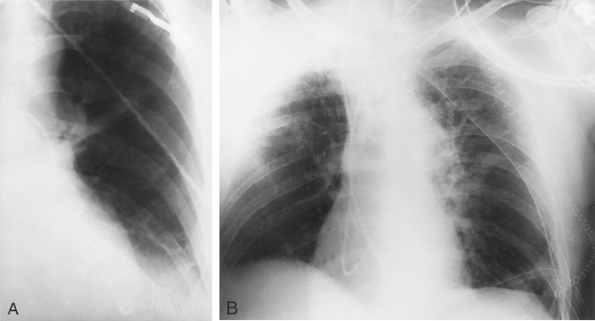 |
Fig. 95-2. A. Radiographic image of the left lung in a donor with borderline gas exchange. Note the left lower lobe atelectasis. Preharvest fiberoptic bronchoscopy revealed a left lower lobe mucus plug that was evacuated, resulting in satisfactory reexpansion of the left lower lobe. B. Postoperative anteroposterior chest radiograph of recipient of the left lung allograft in (A) reveals satisfactory expansion of the allograft. The patient obtained an excellent result. |
In certain circumstances, the donor selection criteria can be somewhat relaxed. A minor degree of pulmonary infiltrate can be accepted in a donor used for a bilateral transplantation. On occasion, a donor is identified with marginal gas exchange and radiographic evidence of a unilateral pulmonary infiltrate. Straznicka and colleagues (2002) have demonstrated a high rate of lung recovery in donors initially declared unsatisfactory by aggressive management of donor care by the organ procurement team.
The use of marginal donors to expand the donor pool was reported by Sundaresan and colleagues (1995a). Of 133 consecutive donors, 44 were considered marginal because of one or more of the standard criteria: age older than 55 years, smoking history greater than 20 pack-years, unsatisfactory chest radiograph, or arterial oxygen tension less than 300 mm Hg. Evaluation of the recipients showed no differences in either the length of mechanical ventilation or the mean alveolar-arterial oxygen gradient (Figs. 95-1 and 95-2). Immediate and intermediate survival was identical
P.1380
for the two groups. Others have written about success with relaxed donor criteria, but Pierre and colleagues (2002) have urged caution with regard to pairing extended donors with recipients who do not meet standard recipient guidelines as espoused by Maurer and co-workers (1998). Specifically, older recipients and recipients with Burkholderia cepacia seemed to have excess mortality risk when given extended donor lungs.
LIVING DONOR TRANSPLANTATION
The shortage of donors remains a major threat to progress in lung transplantation. Long waiting lists for organs translate to higher rates of death among potential recipients listed for transplantation. One controversial proposed solution to the critical shortage of cadaveric lung donors has been the concept of living related donors. Starnes and colleagues (1997) have the most extensive experience with living-donor transplantation and have expanded the indications beyond CF to include pulmonary hypertension, pulmonary fibrosis, and assorted other etiologies of pulmonary failure. The reports from this group describe 38 living-donor transplantations performed in 27 adults and 10 children with a 38% perioperative mortality rate. Complications resulting from the 76 donor lobectomies included postpericardiotomy syndrome, atrial fibrillation, and surgical reexploration. Living donors are a rarely used solution to the donor shortage, amounting to 30 to 40 procedures a year for the years 1994 to 1996, and accounting for less than 2% of total donors in 2001 as reported by the ISHLT (2003). This technique has now been used worldwide for more than 250 cases with no reports of mortality among the living donors, but the greatest impediment to the expanded use of this strategy is the potential risk for injury or death to a previously healthy donor. Starnes and colleagues (2003) reported experience with 128 living lobar transplants in 123 recipients over 10 years. The recipients included 83 adults and 39 children with more than 2 years of mean follow-up. The early survival estimates were 70%, 53%, and 44% for 1, 3, and 5 years, respectively. Battafarano and colleagues (2000) reported substantial morbidity that included complications in 60% of more than 60 living lobar donors. Although there are no reported deaths in a donor, the risks to a healthy lobar donor remain an important obstacle preventing widespread use of this solution to the donor shortage.
LUNG PRESERVATION
Lung preservation has been the focus of intense laboratory interest since the start of lung transplantation. Many authors have reviewed the current state of the art of lung preservation, including Novick and co-workers (1996), as well as Unruh (1995). Clinical pulmonary preservation has progressed considerably since the Toronto Group initially carried out unilateral lung transplantation using donor lungs harvested in an atelectatic state and stored by topical hypothermic immersion, as reported by Todd and associates (1988). Major advances have been made in the understanding of the molecular events of lung reperfusion injury, and as a result, improvements have been made in clinical strategies for lung preservation. Minor differences occur in the preservation strategies of most clinical lung transplant programs, but the basic principles remain the same.
After systemic donor heparinization and just before circulatory arrest, a pulmonary vasodilator is used, usually administered by direct bolus injection into the pulmonary artery. We use 500 g of prostaglandin E1 (PGE1). Pulmonary arterial flush is then achieved with the lungs in a state of moderate inflation at an Fio2 greater than room air. In recent years, there has been increasing experimental and clinical evidence of the benefit of low-potassium dextran as a pulmonary flush solution, and most experienced programs have adopted such a solution commercially available as Perfadex (Vitro Life, Goteburg, Sweden). After extraction, the lung allograft is immersed in iced crystalloid solution and maintained in a semiinflated state during transport. This technique results in reliable allograft function with ischemic times of up to 6 hours. We have, on occasion, extended the ischemic time, particularly for the second lung of a bilateral sequential transplantation, in which the ischemic time has reached 8 to 10 hours with satisfactory subsequent function.
The delivery of the pulmonary flush solution is typically performed in an antegrade manner through the main pulmonary artery. The addition of retrograde perfusion, either before or after antegrade flush, has been described by Varela and colleagues (1997), and this technique has been used in our clinical program with success. There are potential benefits of improved distribution of flush solution with retrograde delivery. In addition, for donors at high risk for acute pulmonary thromboembolism, retrograde flush can identify and remove embolic clot from the pulmonary artery (clot that might otherwise go undetected if flush is delivered only in an anterograde fashion).
Inflation
The authors formerly believed that hyperinflation of donor lungs was advantageous, as demonstrated by the work of Puskas and colleagues (1992). After using this technique in our clinical program and experiencing an increased incidence of reperfusion edema as a result, we have stopped using hyperinflation. We now recommend that lungs be flushed and stored at a moderate stage of inflation consistent with normal end-tidal volumes.
Temperature of Flush and Storage
In virtually all clinical lung transplantation programs, pulmonary artery flush temperature is 1 to 4 C. After extraction, lungs are immersed in crystalloid solution and packed in
P.1381
ice, resulting in their storage and transport at about 1 C. Some investigators have shown that a more moderate degree of hypothermia (10 C) results in superior lung function. We demonstrated this principle in our own laboratory in an in vitro rabbit lung perfusion model by Wang and co-workers (1993) as well as a standard model of canine left lung allotransplantation and bilateral baboon lung transplantation documented by Sundaresan and associates (1993a). In a previous study, however, Mayer and colleagues (1992) were unable to show a difference between storage at 4 C versus 10 C in canine left lung allografts. The current practice worldwide, as described by Hopkinson and co-workers (1998), is divided, with 70% of programs storing grafts at 0 to 5 C, and 30% storing at 5 to 10 C.
Pharmacologic Manipulation
In addition to their apparent benefit when administered before pulmonary artery flush, as documented by Mayer and co-workers (1992), evidence suggests that vasodilator prostanoids also may have some beneficial effect in the early posttransplantation period. The authors continued this work, demonstrating that PGE1 significantly improves canine lung allograft function after an 18-hour ischemic period, as noted by Aoe and colleagues (1994). The authors continue to use PGE1 routinely during the postoperative period in our clinical program. A mounting body of evidence suggests that oxygen-free radicals are important in the genesis of ischemia reperfusion injury in the lung. This subject was concisely reviewed by Christie and Waddell (1993). Other antioxidant interventions, including enzymatic (superoxide dismutase, catalase, glutathione peroxidase) as well as nonenzymatic (allopurinol, glutathione, dimethyl-thiourea and lazaroid), have shown impressive results in reducing lung reperfusion injury. Some of these agents have been used with success in clinical lung transplant programs.
The use of inhaled nitric oxide (NO) has been shown to be beneficial in many steps of the lung transplant process. We have demonstrated that inhaled NO administered to the lung recipient is effective in reducing early allograft dysfunction. Date and associates (1996) reported these findings. Fujino and colleagues (1997) reported our work showing that inhaled NO administered to the donor at the time of organ procurement also reduces posttransplantation reperfusion injury. A recent comparative study by Thabut and colleagues (2001) confirms the beneficial effects of nitric oxide in the lung recipient. Aredehali and associates (2001) could not show a reduction of clinical reperfusion injury with inhaled NO, but did show improvements in gas exchange and pulmonary artery pressures. The Toronto group, as reported by Meade and associates (2003), recently noted the results of a prospective randomized trial of inhaled nitric oxide therapy in lung transplant recipients. They observed no beneficial effect in patients receiving nitric oxide within 10 minutes of reperfusion, but the study was not restricted to those patients with a developing or established reperfusion injury. The role of inhaled nitric oxide in lung transplantation remains controversial, but the authors remain convinced that it has a beneficial effect in reducing the frequency and severity of reperfusion injury.
The mechanism of ischemia-reperfusion injury is complex but is believed to include activation of leukocytes that eventually produce free radical oxygen species and thereby cause endothelial damage. One approach to minimizing reperfusion injury is to avoid leukocyte activation during initial reperfusion. This goal has been met in several ways, including the inhibition of neutrophil adhesion, as described by Schmid and co-workers (1997), and the complete elimination of leukocytes from the reperfusate solution during the early critical minutes of reperfusion, as reported by Shiraishi and colleagues (1998).
Promising work has been produced on the effects of controlled reperfusion of the lung allograft after implantation. This work is an extension of studies performed originally on ischemic hearts, such as those of Okamoto and colleagues (1986). Bhabra and colleagues (1996) demonstrated improved graft function if the initial 10 minutes of reperfusion were controlled to limit the pulmonary artery pressure to 50% of the physiologic pressure. Halldorsson and colleagues (1998a, 1998b) controlled both the pressure and composition of the perfusate for 10 minutes, using a low-pressure, substrate-enriched, hypocalcemic, hyperosmolar, alkaline solution and demonstrated better lung function in all measured parameters.
Technique
Donor Lung Extraction
Donor extraction technique was reported by Sundaresan and associates (1993b). After the lung extraction team's arrival at the donor hospital, it is important for the team to assess the chest radiographs and to perform fiberoptic bronchoscopy. Final assessment is made by gross inspection of the lungs, which are exposed by median sternotomy performed in conjunction with the midline laparotomy for extraction of abdominal organs.
The abdominal organs are prepared for extraction by the responsible surgical teams. It is important for the liver extraction team to insert a large-caliber cannula in the inferior vena cava for liver flush effluent rather than planning to vent the hepatic flush into the chest through the divided inferior vena cava, thereby obscuring the thoracic organ extraction team's view.
Both venae cavae are encircled within the pericardium. The aorta is mobilized and encircled. Care must be taken to avoid injury to the right main pulmonary artery lying immediately posterior to the superior vena cava and ascending aorta. It is not necessary to dissect the main pulmonary artery.
The donor is heparinized. A cardioplegia cannula is placed in the ascending aorta. A large-bore pulmonary flush cannula then is placed in the main pulmonary artery immediately
P.1382
proximal to its bifurcation. PGE1, 500 g, is administered directly into the main pulmonary artery, which produces an immediate fall in systemic pressure. At this point, venous inflow occlusion is achieved by double ligation of the superior vena cava and clamping of the inferior vena cava at the diaphragm. The aorta is then cross-clamped, and cardioplegic solution is initiated. Cardioplegia is vented through the inferior vena cava, which is divided immediately above the previously placed clamp. After cardioplegic arrest has been achieved, lung flush is started. With the lungs maintained in a state of moderate inflation, pulmonary artery flush is achieved with 3 L of modified Euro-Collins solution delivered at a pressure of 30 cm H2O. This solution is vented through the amputated tip of the left atrial appendage (Fig. 95-3). Cold effluent is allowed to collect in both pleural spaces. Topical hypothermia is supplemented by crushed ice.
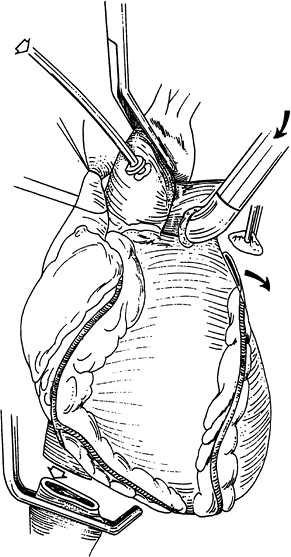 |
Fig. 95-3. Cardioplegia is administered proximal to an aortic cross-clamp and vented through the transected inferior vena cava (open arrow). Pulmonary flush solution is administered through the main pulmonary artery and vented through the amputated tip of the left atrial appendage (solid arrows). |
 |
Fig. 95-4. The ascending aorta is divided. The main pulmonary artery has been transected at its bifurcation. The heart is retracted upward and to the right to enable safe division of the left atrium, leaving suitable cuffs on both cardiac and lung allografts. |
We prefer to extract the donor heart in situ. It should be stated emphatically that satisfactory cardiac and bilateral lung grafts can be safely extracted in every situation. The superior vena cava is divided between the previously placed ligatures, once again taking care not to injure the underlying right main pulmonary artery. The aorta is divided superior to the cardioplegia cannula. The main pulmonary artery then is divided through the cannulation site. The heart then is elevated and retracted to the right. The left atrium is opened midway between the coronary sinus and the inferior pulmonary vein. The left atrial incision is continued toward the right. The right side of the left atrial wall is divided, taking care to preserve a rim of atrial muscle on the pulmonary vein side (Fig. 95-4). This step completes the cardiac excision.
Extraction of the lungs is continued by mobilization and division of the trachea well above the carina. The entire thoracic contents then are extracted from the spine in a caudal direction. The lung allografts are immersed in cold crystalloid solution and transported semiinflated. Should each lung be used in different transplantation centers, they are separated into distinct allografts at the donor hospital. The donor left main bronchus is divided at its origin with a cutting stapling device to leave the airway to both lungs sealed (Fig. 95-5). Otherwise, the grafts should be transported en bloc for separation immediately before implantation. On arrival at the recipient hospital, the graft is exposed and kept cold during the remainder of its preparation. The esophagus and aorta are removed, taking care to leave all other soft tissues on the specimen side to maximize bronchial arterial collateral flow to the donor lung.
The posterior wall of the left atrium is divided, leaving equal atrial cuffs on both sides. The pulmonary artery is divided at its bifurcation (see Fig. 95-5). It is important to separate the pulmonary artery from its pericardial attachments on each side out to the first pulmonary arterial branch. This separation prevents compromise of pulmonary
P.1383
artery caliber distal to the pulmonary artery anastomosis after implantation.
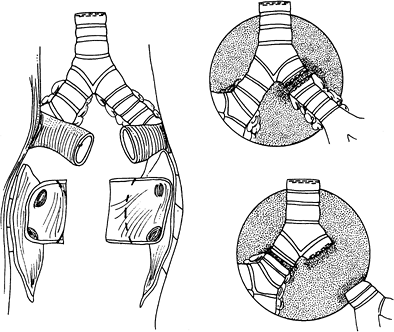 |
Fig. 95-5. The pericardium and left atrium are divided with the left atrium further trimmed (dotted lines). The airway is transected and kept sealed using a GIA stapling device across the proximal left main-stem bronchus. The donor airway is further revised for implantation, as shown at the bottom right. |
Subcarinal nodes are divided, and the left main bronchus is transected. The left main bronchus is dissected from nodal tissue and divided at a point two rings proximal to the upper lobe orifice. On the right side, excision of the carina usually provides an adequate length (two rings proximal to the upper lobe origin) for subsequent bronchial anastomosis. It is important during dissection of the bronchus to minimize any nodal dissection at the site of bronchus transection to maximize retrograde bronchial collateral blood flow to the donor bronchus after transplantation.
Recipient Preparation
Anesthesia
A successful lung transplantation program requires active involvement of expert anesthesiologists familiar with complex cardiothoracic anesthesia techniques, bronchoscopy, and cardiopulmonary bypass. Full hemodynamic monitoring is required in every patient. We routinely use a Foley catheter, central venous line, pulmonary artery Swan-Ganz catheter, and radial artery catheters. We routinely supplement the radial artery catheter with a femoral artery line. This provides more accurate hemodynamic monitoring during periods of difficult dissection associated with hypotension as a result of mediastinal retraction. In addition, a central arterial line is more accurate in the presence of the inevitable hypotension that accompanies these procedures. We also use a transesophageal echocardiographic probe in every patient, but its application is especially critical in patients with severe pulmonary hypertension and coexistent right ventricular dysfunction.
The airway is routinely intubated with a left-sided double-lumen endobronchial tube. In small patients, a single-lumen tube with an endobronchial Fogarty catheter enables independent ventilation; however, this technique does not have the reliability of a double-lumen tube. A single-lumen tube can present difficulties, particularly in a bilateral transplant recipient in whom intraoperative maneuvering of the tube can be troublesome. For small-stature adults or pediatric recipients, a single-lumen tube is occasionally used with the expectation that cardiopulmonary bypass will be used during the explantation and implantation. In patients with CF, thick, tenacious purulent secretions are continuously expressed into the bronchial lumen during manipulation of the lungs for extraction. It is extremely difficult to evacuate secretions from the airway, particularly through a small-caliber double-lumen endotracheal tube. These secretions can result in impaired ventilation. To minimize this problem, we generally place a large-caliber, single-lumen tube is placed and, using a flexible fiberoptic bronchoscope, irrigate and aspirate the airway as much as possible before placement of the double-lumen tube and initiation of the procedure. Aprotinin is used routinely when the need for cardiopulmonary bypass is anticipated or expect intrapleural adhesions are encountered, such as in patients with CF, bronchiectasis, or previous thoracic surgery.
Single-Lung Transplantation
Choice of Side
The authors prefer to transplant the side having the lesser function as judged by preoperative quantitative nuclear perfusion scans. It was argued previously that the right side was preferable for patients with obstructive lung disease. However, there is no difference in functional outcome among single-lung recipients regardless of transplant side. If cardiopulmonary bypass is anticipated, as in patients with primary pulmonary hypertension or severe pulmonary fibrosis with associated pulmonary hypertension, the right side is the preferred transplant side. For patients with Eisenmenger's syndrome, the right side is used to facilitate closure of the coexisting atrial or ventricular septal defect. A patent ductus arteriosus can be repaired in association with transplantation to either side.
Exposure
A generous posterolateral thoracotomy through the fifth interspace or bed of the excised fifth rib is the preferred approach. However, an anterolateral incision through the fourth interspace with division of the medial fourth costal
P.1384
cartilage provides excellent exposure as well. This muscle-sparing approach has been described by Pochettino and Bavaria (1997) and has been used successfully in our program as well. For right-sided transplants for which cardiopulmonary bypass is anticipated, cannulation of the ascending aorta is facilitated by the use of a fourth interspace incision. Median sternotomy can be used for right-sided transplants, especially if associated cardiac repair dictates an anterior approach permitting access to the left side of the heart. Femoral partial bypass was formerly our technique of choice; however, intrathoracic cannulation avoids a groin incision and the necessary arterial and venous repairs following decannulation. The ascending aorta and right atrium can be cannulated easily through the right chest. The cannulas are positioned in the anterior aspect of the incision and remain well out of the operative field throughout the procedure. Through a left posterolateral thoracotomy, the proximal left pulmonary artery and descending aorta can be adequately cannulated, but the aortic cannula can inhibit subsequent placement of the donor lung in the posterior aspect of the left side of the chest (see Addendum).
Recipient Pneumonectomy
After adequate exposure of the pleural space, pleural adhesions are divided. Adhesions can be extensive in patients with fibrotic or septic lung disease but ordinarily are absent in patients with emphysema and primary pulmonary hypertension. Extreme care is taken not to injure the phrenic and recurrent laryngeal nerves. The inferior ligament is divided. The pulmonary veins and main pulmonary artery are encircled outside the pericardium. During this dissection, the need for cardiopulmonary bypass is determined. Ventilation of the contralateral lung and occlusion of the ipsilateral pulmonary artery determine whether the contralateral native lung will provide adequate gas exchange and hemodynamics to tolerate pneumonectomy and implantation without cardiopulmonary bypass. Assessment of right ventricular contractility with the transesophageal echo probe is especially useful at this point.
The first branch of the pulmonary artery then is ligated and divided. The pulmonary artery just distal to this branch is stapled proximally and ligated distally to eliminate back-bleeding after division. The pulmonary veins are divided between staple lines or between silk ligatures placed on each venous branch at the hilum. This latter option increases the size of the subsequent left atrial cuff. Peribronchial nodal tissue is divided, and bronchial arterial vessels are secured with ligatures. The bronchus is transected just proximal to the upper lobe origin, and the lung is excised (Fig. 95-6). The recipient bronchus is then trimmed back up into the mediastinum, taking care to avoid any devascularization of the recipient bronchus at the site of anastomosis. The pericardium around the vein stumps then is widely opened, and hemostasis is achieved in the mediastinum.
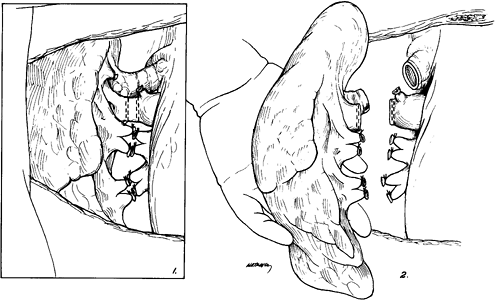 |
Fig. 95-6. Excision of the native right lung. The pulmonary artery is stapled beyond its first upper lobe branch. Pulmonary veins are divided between ligatures and the bronchus is transected just proximal to the upper lobe orifice. |
Implantation
The donor lung, wrapped in cold, moist gauze, is placed in the posterior portion of the thorax. In this position, manipulation of the lung can be avoided during the entire implantation. The lung is kept cold by topical application of crushed ice. This topical hypothermia provides an extended period of cold preservation, giving additional time for meticulous anastomoses.
The bronchial anastomosis is performed first (Fig. 95-7). Various techniques have been described. The membranous posterior wall using a continuous suture of 4 0 absorbable monofilament suture. The anterior cartilaginous airway is then closed with four or five interrupted figure-of-eight sutures. In our experience reported by Date and associates (1995), this procedure results in the lowest incidence of anastomotic complications. For small-caliber bronchi, an end-to-end closure is obtained using simple interrupted sutures of monofilament absorbable material. The bronchial anastomosis is always covered using local peribronchial nodal tissue.
A vascular clamp is then placed as proximal as possible on the ipsilateral main pulmonary artery. The donor and recipient arteries are trimmed to size, and an end-to-end anastomosis is created using 5-0 polypropylene sutures (Fig. 95-8). It is important, of course, to maintain proper orientation of donor to recipient artery and to avoid compromising the lumen during creation of the anastomosis. Lateral traction on the pulmonary vein stumps enables central placement of an angled atrial clamp. For right-sided transplants, it is occasionally necessary to open the intraatrial groove to increase the length of recipient left atrium available for clamp placement. Pulmonary vein stumps are then amputated, and the bridge of tissue between the two is incised to create a suitable cuff for the left atrial anastomosis (Fig. 95-9). Every effort should be
P.1385
made to create this anastomosis with an everting technique so as to achieve good intima-to-intima apposition and exclude atrial muscle from the lumen. After completion of this anastomosis but before tying the final stitch, the lung is gently inflated while the pulmonary artery clamp is temporarily removed, enabling the lung to be de-aired through the open left atrial anastomosis. All suture lines are then secured and inspected, and the vascular clamps are removed.
 |
Fig. 95-7. A right bronchial anastomosis is depicted, with the lung cooled by topical crushed ice. A. The membranous wall is closed first. B. The cartilaginous wall is closed with interrupted figure-of-eight sutures without any attempt to intentionally telescope one end into another. C. Small bronchi are joined with simple interrupted sutures to avoid even the smallest amount of narrowing caused by the figure-of-eight sutures. Peribronchial nodal tissue covers the anastomosis. From Meyers BF, et al: Bilateral sequential lung transplantation without sternal division eliminates posttransplantation sternal complications. J Thorac Cardiovasc Surg 117:358, 1999. With permission. |
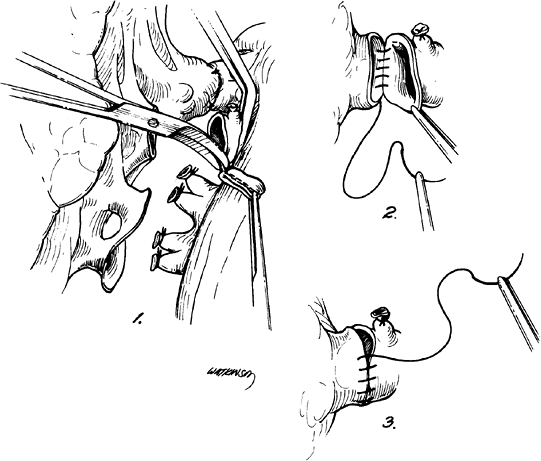 |
Fig. 95-8. A central pulmonary artery clamp is placed, the staple line is excised, and an end-to-end anastomosis is constructed with 5-0 polypropylene. |
If bypass was used, it can be discontinued safely at this point. Reperfusion begins with the recipient receiving a continuous infusion of PGE1. This infusion is continued for at least 24 hours after transplantation, unless the recipient is hypotensive and the pulmonary arterial pressures are correspondingly low. The use of bolus corticosteroid administration during implantation is controversial.
Two drains are left in each pleural space, and routine closure is performed using nonabsorbable pericostal sutures and absorbable material for fascia and skin. At the termination of the procedure, the double-lumen endotracheal tube is replaced with a large-caliber, single-lumen tube. Flexible bronchoscopy is performed to inspect the bronchial anastomosis and to clear the airway of any blood or secretions.
 |
Fig. 95-9. A central left atrial clamp is in place while the vein stumps are amputated and the bridge of atrial muscle is divided; 4-0 polypropylene suture is used to complete the anastomosis. |
P.1386
Bilateral Lung Transplantation
Exposure
Traditionally, bilateral sequential single-lung transplantation is conducted through bilateral anterolateral fourth or fifth interspace thoracotomies connected by a transverse sternotomy (Fig. 95-10). This clamshell approach for bilateral transplantation, as described by Pasque and associates (1990), provides adequate exposure for safe division of pleural adhesions. In patients with cystic fibrosis, adhesions can be particularly dense at the apex and posterior aspect of the chest. In addition, this incision provides satisfactory exposure for institution of cardiopulmonary bypass by ascending aortic and right atrial cannulation. However, the authors no longer divide the sternum because we have found that adequate exposure (Fig. 95-11) is achieved to conduct a safe transplant procedure while avoiding the complications of sternotomy. Results, as published by Meyers and colleagues (1999), demonstrated the safety of a sternal sparing approach and the complete avoidance of sternal complications, such as the migration of the stabilizing pin required to maintain sternal alignment after a full clamshell incision (Fig. 95-12).
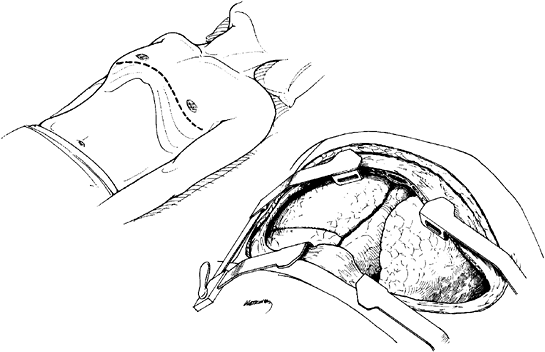 |
Fig. 95-10. Bilateral anterolateral thoracotomies are performed through the fourth or fifth interspace with transverse division of the sternum. |
Pneumonectomy and Implantation
The techniques of pneumonectomy and implantation are identical to those just described for single-lung transplantation. The side with worse function, as determined by preoperative ventilation and perfusion scans, is replaced first. Cardiopulmonary bypass may prove necessary at several junctures during bilateral sequential transplantation. In rare patients with small airways not amenable to double-lumen tube placement, cardiopulmonary bypass is instituted after mobilization of both lungs and is maintained during bilateral extraction and implantation. Occasionally, the remaining contralateral native lung does not enable satisfactory gas exchange or hemodynamics during removal or replacement of the first lung. Cardiopulmonary bypass is instituted at that point. The most common situation in which bypass proves necessary occurs after implantation of the first lung. The transplanted lung may not support the recipient's circulation and gas exchange, manifesting as progressive increases in pulmonary artery pressure despite increasing doses of PGE1. Pulmonary edema develops with associated hypoxemia. Although this clinical phenomenon is typical, its etiology is not well understood. It may occur because of poor preservation or, alternatively, from systemic bacteremia in the recipient because it is observed commonly after implantation of the first lung in cystic fibrosis patients. It is prudent to institute cardiopulmonary bypass as soon as this problem develops rather than waiting until it
P.1387
P.1388
has become an emergent situation in an unstable patient. On the other hand, Szeto and colleagues (2002) suggest that early and prophylactic cardiopulmonary bypass provides saftey without any observed negative effects of cardiopulmonary bypass.
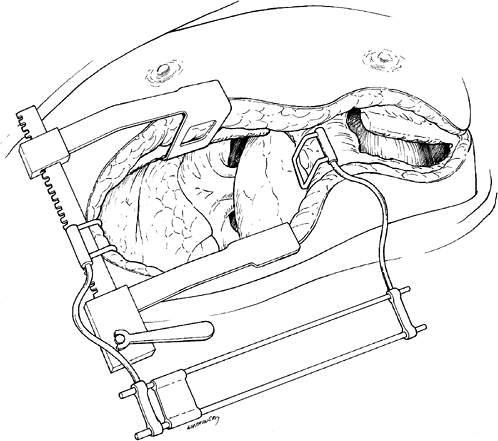 |
Fig. 95-11. A Finichietto chest retractor is used to spread the ribs vertically, while a Balfour retractor is placed with one jaw on the sternum and one jaw on the muscle and skin of the lateral chest. The intercostal muscle division is carried far more lateral and posterior than the skin incision to maximize rib spreading. The combined effects of these two retractors typically result in excellent exposure without sternal division. From Meyers BF, et al: Bilateral sequential lung transplantation without sternal division eliminates posttransplantation sternal complications. J Thorac Cardiovasc Surg 117:358, 1999. With permission. |
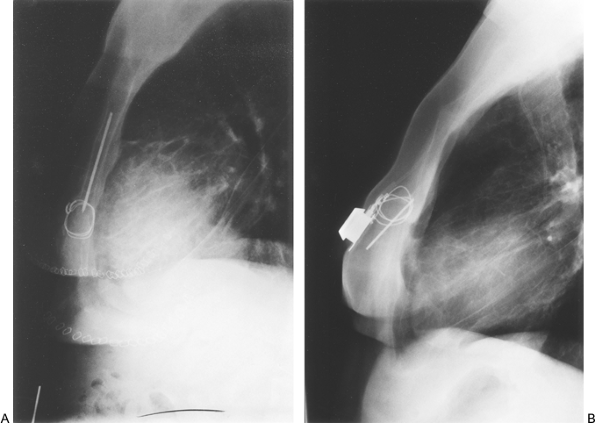 |
Fig. 95-12. These lateral radiographs show patients immediately after bilateral sequential lung transplantation using a standard clamshell thoracosternotomy. In the first radiograph (A), one of the sternal K wires has migrated out of the sternum and resides in the anterior abdominal wall. In the second radiograph (B), a K-wire has protruded through the anterior sternum, and its sharp end resides just beneath the skin. Both pins required surgical removal. Use of Steinmann pins, or avoidance of transverse sternotomy, will eliminate the possibility of K-wire migration. |
POSTOPERATIVE MANAGEMENT
Ventilation
In general, patients are ventilated with standard ventilatory techniques. The Fio2 value is kept at a level so as to maintain the Pao2 greater than 70 mm Hg. A tidal volume of 10 to 12 mL/kg is usually sufficient, and PEEP of 5 to 7.5 cm H2O is used in most patients. Extubation is performed in accordance with standard requirements of satisfactory gas exchange and mechanics. Most patients are extubated within 24 to 48 hours of transplantation following a standard intermittent mandatory ventilation (IMV) or pressure support wean. This type of ventilatory management is applied in all bilateral lung transplant recipients as well as in single-lung recipients undergoing transplantation because of pulmonary fibrosis.
Patients undergoing single-lung transplantation for chronic obstructive lung disease or pulmonary vascular disease are managed differently, however. In the former condition, we make an effort to avoid the use of PEEP and select tidal volumes that are somewhat lower than would ordinarily be used. These adjustments are made to try to reduce hyperinflation of the contralateral hypercompliant native lung with resultant compression of the less compliant transplanted lung. This situation can be a major problem (Fig. 95-13). In some patients, volume reduction of the native lung by lobectomy can be performed to decompress the contralateral transplanted lung either late postoperatively, as described by Kroshus and associates (1996), or at the time of transplantation, as reported by Todd and colleagues (1997). In patients with pulmonary vascular disease, we use a prolonged period (48 to 72 hours) of elective ventilation. Patients are kept heavily sedated and often paralyzed for that period of time. The authors choose to maintain these patients in a position with the native lung dependent so as to maintain inflation and appropriate drainage of the transplanted lung. Tidal volumes are standard, but PEEP of 7.5 to 10 cm H2O is applied.
Another unique and notable situation in the immediate postoperative care of lung transplant recipients is the phenomenon of hyperexpansion of undersized graft lungs. Kozower and co-workers (2003) has reported observations that undersized grafts can lead to undesirable hyperexpansion of the lungs when negative pleural pressure is created with chest tubes during mechanical ventilation. Haddy and colleagues (2002) reported a similar observation in undersized lobar lung transplants. The solution is prevention by avoiding negative pleural pressure and positive-pressure ventilation in recipients with undersized grafts.
In some patients, early graft dysfunction, rejection, or infection necessitates a prolonged period of postoperative mechanical ventilation. Tracheostomy should be performed early in the postoperative course. The procedure facilitates mobilization of the patient, improved oral nutrition, and generally a more positive attitude in the ventilator-dependent patient.
Fluid Management
During the first few postoperative days, fluid management is monitored carefully by determination of pulmonary capillary wedge pressure and daily weight. Despite the vigilance of our anesthesiology colleagues, most patients return from the operating room with a significant positive fluid balance. Diuretics are used aggressively during the early postoperative period. On occasion, patients undergoing single-lung transplantation for primary pulmonary hypertension develop hemodynamic instability if the filling pressures on the right side of the heart are excessively reduced. These patients may require higher filling pressures during the first weeks after transplantation.
Sepsis Prophylaxis
Bacterial Infection
All patients are given routine antibacterial prophylaxis, most often with cefepime and vancomycin. Administration of these agents is continued for several days. Adjustments to these empiric antibiotics are made based on the results of donor and recipient bronchial cultures performed at the time of surgery. In the CF population, aerosolized colistin or tobramycin is also used. In addition to the broad-spectrum antibiotics noted, cystic fibrosis patients also require specific antipseudomonal coverage as dictated by the sensitivities of their preoperative sputum cultures.
Viral Infection
Herpes simplex was formerly a frequent cause of postoperative morbidity because of oral ulcerations as well as occasional pneumonitis. The routine use of acyclovir prophylaxis, however, has eliminated herpes infection as a frequent postoperative complication. We have employed a low-dose suppressive regimen that remains in effect for the life of the recipient. CMV remains a significant problem in pulmonary transplant recipients. Most programs have adopted the strategy of matching seronegative donors to seronegative recipients. The highest incidence of severe CMV infection occurs in seronegative recipients receiving lungs from seropositive donors. In these patients, prophylaxis with intravenous ganciclovir is used routinely according to the following protocol: 5 mg/kg per day for the first
P.1389
12 weeks after operation. It is reasonable to apply this prophylaxis regimen in any circumstance in which either the donor or the recipient is seropositive. In other recipients, the ganciclovir is given for shorter courses at the same dosing level but only in the setting of a proven viremia or CMV pneumonitis.
 |
Fig. 95-13. A. Anteroposterior chest radiograph from a patient with obstructive lung disease 1 day after right single-lung transplantation. Note a modest perihilar infiltrate in the allograft, presumably from reimplantation edema. Modest mediastinal shift to the allograft side is observed. B. One week later, hyperexpansion of the native left lower lobe is observed, along with further shift of the mediastinum and compression of the allograft. The patient underwent left lower lobectomy on postoperative day 9. C. Left lower lobe resection enabled the mediastinum to shift back toward the midline with decompression of the allograft. |
Fungal Infection
It has not been the authors' practice to use routine fungal prophylaxis. However, in a circumstance in which a heavy growth of yeast is identified posttransplantation in donor bronchial culture, prophylactic low-dose amphotericin is justified. Some anecdotal reports cite early systemic Candida septicemia occurring in patients receiving organs from donors whose bronchial cultures grew Candida. The authors have encountered patients with early postoperative ischemic necrosis of the graft bronchus who have been shown to culture Aspergillus from the airway. These patients have been treated with itraconazole with good result.
Pneumocystis carinii
Pneumocystis carinii parasite was an occasional cause of postoperative pulmonary infection until routine use of trimethoprim-sulfamethoxazole prophylaxis eliminated it
P.1390
as a significant pathogen. Our current strategy includes dosing three time per week for life. Alternative agents, such as monthly application of inhaled pentamidine, are administered when there is an allergy to sulfa medications.
Immunosuppression
The frequency and severity of acute rejection episodes are predictive of subsequent chronic rejection. Therefore, maintenance immunosuppression and effective therapy of acute rejection are critically important. Induction therapy with cytolytic agents or an interleukin-2 (IL-2) receptor blocker decreases early rejection rates, as reported by Brock and associates (2001). As a result of ease of administration, fewer side effects, similar efficacy, and potentially fewer opportunistic infections, IL- 2 receptor blockers are becoming the induction agents of choice in centers opting for an induction therapy strategy. Optimal maintenance therapy is not clear at this time. Virtually all patients receive a calcineurin inhibitor. Cyclosporine (Neoral, Gengraf, Sandimmune) are used in 60% of recipients, and the other 40% receive tacrolimus (FK-506, Prograf) during the first year. During the same interval, more than 50% of patients receive azathioprine (Imuran), and 40% are on a mycophenylate mofetil (Cellcept) regimen. A switch from cyclosporine to tacrolimus is a common first immunosuppression adjustment due to cyclosporin toxicity or persistent acute rejection episodes despite adequate cyclosporin dosage as suggested by Horning (1998) and Vitulo (2002) and their co-workers. The roles of newer agents such as sirolimus [rapamycin (Rapamune) and rapamycin derivative (Novartis)] or leflunomide (Arava), a pyrimidine synthesis inhibitor, are evolving in lung transplantation based on early successes in other organ.
The use of perioperative corticosteroids is controversial. Most physicians have adopted the use of moderate-dose corticosteroid (methylprednisolone, 0.5 to 1 mg/kg per day intravenously) for several days before initiating an oral dose of prednisone, 0.5 mg/kg per day. However, withholding the first few days of prednisone has neither an adverse nor a beneficial effect on bronchial healing and may, in fact, lessen the risk for perioperative sepsis.
Infection-Rejection Surveillance
The use of radiographic, clinical, and physiologic criteria has been insufficient to delineate adequately infection from rejection in the early posttransplantation lung recipient. For this reason routine fiberoptic bronchoscopy is performed whenever there is a clinical indication in the absence of recently identified, untreated organisms identified by sputum culture. The advantage of routine flexible bronchoscopy is that it enables performance of bronchoalveolar lavage and transbronchial biopsy. Although bronchoalveolar lavage has not proven useful in the diagnosis of rejection, it is invaluable in the identification of opportunistic infection commonly encountered in transplant recipients. Transbronchial biopsy has proved to be the major tool in the diagnosis of pulmonary rejection. We have used this procedure frequently, both as a routine surveillance and in patients with unexplained pulmonary infiltrates. Routine bronchoalveolar lavage and transbronchial biopsies are performed at 2 to 3 weeks; 2, 3, 6, and 12 months; and annually thereafter.
Regardless of the method of diagnosis, if rejection is indeed the problem, a dramatic improvement in clinical findings, radiographic evidence (Fig. 95-14), and Pao2 value will be observed within 8 to 12 hours after administration of 15 mg/kg of methylprednisolone.
COMPLICATIONS
Technical Error
As in any major operative intervention, a variety of technical complications may be encountered during the perioperative period.
Postoperative Hemorrhage
Hemorrhage was once a frequent complication. Indeed, in the early experience of some programs undertaking heart-lung and en bloc double-lung transplantations, about 25% of patients required reoperation for postoperative hemorrhage. With current surgical techniques, however, such as posterolateral thoracotomy for single-lung transplantation and the clamshell or sternal-sparing clamshell incisions for bilateral lung replacement, surgical exposure is superb. In addition, aprotinin administration has dramatically reduced intraoperative and postoperative bleeding, especially in patients with extensive pleural adhesions requiring cardiopulmonary bypass.
Anastomotic Complications
Bronchial anastomotic complication are much less frequently encountered than in the early days of lung transplantation. Improvements in lung preservation, surgical technique, and superior perioperative immunnosuppressive protocols have reduced the incidence of these complications. Vascular anastomotic complications can also occur and result in postoperative graft dysfunction. Date and colleagues (1995) evaluated the clinical factors associated with airway complications after lung transplantation. Most airway complications can be managed conservatively by airway d bridement or temporary stenting. Most heal and provide a satisfactory outcome. A variety of stents are available for persistent or malacic strictures. Griffith and associates (1994)
P.1391
reported their experience with anastomotic complications after lung transplantation and made a number of important technical points. A technically unsatisfactory bronchial anastomosis is routinely identified in the operating room at postimplantation bronchoscopy. Inadequate anastomotic caliber dictates immediate surgical revision.
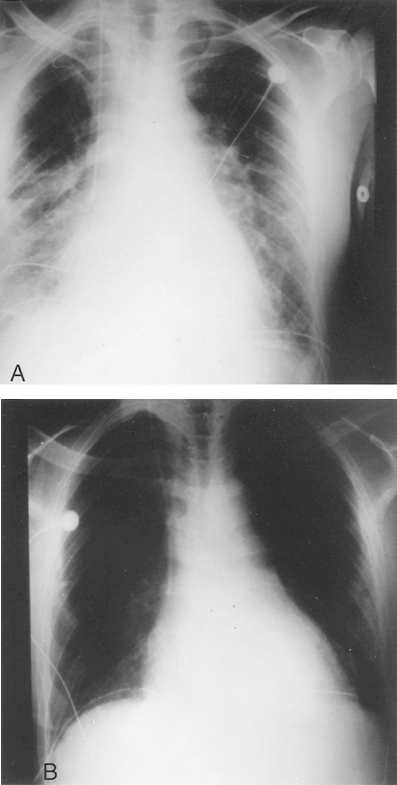 |
Fig. 95-14. Posteroanterior chest radiographs from a patient 7 days after bilateral sequential single-lung transplantation. A. On the morning of postoperative day 7, note bilateral diffuse infiltrate. A diagnosis of rejection was made, and the patient received sodium thiopental (Solu-Medrol), 1-g intravenous bolus. B. Eight hours later, dramatic improvement in the infiltrate is consistent with the typical response of acute rejection to steroid bolus therapy. |
Pulmonary Hypertension and Hypoxemia
Persistent pulmonary hypertension and unexplained hypoxemia can occur as a result of stenosis at the pulmonary artery anastomosis. A nuclear perfusion scan that demonstrates less than anticipated flow to a single-lung graft or unequal distribution of flow in a bilateral lung recipient can suggest this problem. Occasionally, transesophageal sonography can visualize a stenotic anastomosis. Contrast angiography, however, should be performed in any patient for whom there is such a concern. At the time of angiography, the pressure gradient across the pulmonary artery anastomosis should be determined. A gradient of 15 to 20 mm Hg commonly is encountered, especially in single-lung recipients in whom most cardiac output is directed to the transplanted lung or in bilateral recipients with a high cardiac output. The need for anastomotic revision is dictated by the clinical situation. Dramatic reduction in flow should not be accepted, however, because the donor bronchus is totally dependent on pulmonary arterial collateral flow.
Compromise in flow across the atrial anastomosis also can occur as a result of unsatisfactory anastomotic technique. Compression of the anastomosis by clot or an omental or pericardial flap brought anterior or posterior to the atrial anastomosis for purposes of bronchial anastomotic cover can also impair ipsilateral pulmonary venous drainage. Impaired venous outflow results in elevated venous pressure and ipsilateral pulmonary edema. Pulmonary artery pressures remain unexpectedly high, and flow through the graft is less than expected. Contrast studies may be helpful in demonstrating a reduced level of flow through the anastomosis. Open exploration occasionally is necessary to confirm the diagnosis and conduct appropriate repair.
Early Graft Dysfunction
According to Haydock and colleagues (1992), about 20% of lung transplant recipients experience severe early graft dysfunction. Although both the severity and the clinical impact of this problem have decreased since that report, primary graft failure remains one of the most frequent causes of death in the first 30 days after transplantation. Graft failure may arise because of unsuspected pathologic findings in the donor lung, such as aspiration, infection, or contusion. Inadequate preservation can occur because of technical difficulties at the time of harvest or prolonged warm ischemia during implantation. Irrespective of its cause, it is important to establish a diagnosis of early graft dysfunction and rule out other treatable conditions. Fiser and colleagues (2001) adopted an aggressive approach to the diagnosis and treatment of early lung dysfunction with an improvement in outcome. We have performed open-lung biopsy at the time of implantation when graft dysfunction is immediately apparent in the operating room. A serologic evaluation for
P.1392
anti-HLA antibodies may reveal evidence for hyperacute rejection in some of these patients.
Typically, these patients exhibit diffuse alveolar damage. In this circumstance, Haydock and colleagues (1992) noted that the patient requires the usual intensive supportive measures with the expectation that the diffuse alveolar damage will ultimately recover and provide satisfactory long-term function. Standard intensive ventilatory and pharmacologic intervention generally suffice, although severe graft dysfunction or coexisting cardiac failure may require extracorporeal membrane oxygenator (ECMO) support. Results with ECMO after lung transplantation have been reported by Meyers and associates (2000b) and were found satisfactory when the lung failure occurred immediately (<24 hours after transplantation). The etiology of graft failure in these cases was reperfusion lung injury. When the deterioration occurs later, it is often multifactorial, associated with lasting pathologic changes in the pulmonary parenchyma and less likely solved by temporary ECMO support. An alternative approach to severe, reversible allograft dysfunction was reported by Eriksson and Steen (1998), who have successfully used core cooling to avoid ECMO while the lung injury heals.
Infection
Bacterial Infection
Bacterial pneumonia is the most commonly encountered infection after lung transplantation. According to Chaparro and Kestin (1997), these infections represent the most common cause of early mortality following lung transplantation. An aggressive approach is taken to identify the specific organism. Frequent bronchoscopy with protected brush should be undertaken if routine sputum cultures fail to provide an identifiable organism. Routine intravenous antibiotic therapy is used, and in most patients, the pneumonia clears rapidly. Patients with CF present a real management dilemma during the postoperative period because they are susceptible to recurrent pulmonary infections from the same Pseudomonas organisms harbored in the airway and upper airway sinuses after transplantation. Snell and associates (1993) emphasized that this is particularly true of patients with highly resistant Pseudomonas cepacia.
Lung abscess occasionally is encountered in lung transplantation recipients. Patients with CF on occasion develop multifocal lung abscesses, presumably as a result of inhaled contamination from upper airway or sinus infection. In single-lung recipients, the native lung is also susceptible to bacterial infection, which can cavitate and produce a lung abscess. The care of these patients is the same as for any other patient with lung abscess. Appropriate broad-spectrum antibiotic therapy is administered, and bronchoscopy is performed to ensure that no airway obstruction is present.
Viral Infection
Viral pneumonitis can occur in the postoperative period. Herpes simplex infection formerly was encountered frequently during the early postoperative phase, although routine use of acyclovir has made it an unusual complication. CMV infection is more commonly encountered when donor or recipient, or both, are CMV seropositive. Ettinger and co-workers (1993) reviewed our experience at Washington University. Ninety-two percent of patients in their report developed CMV infection, with 75% of them having biopsy-proven CMV pneumonitis. The donor-negative, recipient-positive combination resulted in more frequent and severe infection. No donor-negative, recipient-negative patients developed infection or disease. Biopsy-proven CMV pneumonitis was associated with radiographic infiltrate in less than 30% of cases. The detection of CMV in bronchoalveolar lavage was not always predictive of CMV pneumonitis. The high incidence of CMV identification reflects the aggressive viral surveillance used in our program.
In high-risk patients, we routinely give prophylactic treatment consisting of 12 weeks of intravenous ganciclovir (5 mg/kg daily), usually commencing 7 to 114 days after transplantation. CMV infection without biopsy-derived proof of CMV disease is not treated. In that circumstance, 5 mg/kg of ganciclovir is administered intravenously twice daily for 2 to 3 weeks. In severe pneumonitis, CMV hyperimmune globulin is also administered. Most patients respond promptly to this regimen. To minimize the development of CMV relapse, the authors have recently employed valganciclovir, an oral ganciclovir derivative that has improved bioavailability.
Fungal Infection
The most frequent cause of significant fungal infection after transplantation is Aspergillus. Once Aspergillus has become a resident organism, it is difficult to clear. In patients without evidence of active invasive infection, we have administered ketoconazole with reasonable success. In patients who fail to clear with ketoconazole or who have developed invasive infection, however, amphotericin is required. Aspergillus infection can become a systemic disease involving multiple organs and usually proves to be fatal.
A particularly interesting group of patients are those having undergone single-lung transplantation for pulmonary fibrosis who develop Aspergillus in the diseased native lung. These patients should be treated aggressively with the expectation that the Aspergillus will not likely clear from the native lung. In this circumstance, contralateral native lung pneumonectomy may be warranted.
P.1393
Pleural Space Complications
Pneumothorax
Pneumothorax is encountered primarily in two circumstances. It can occur as a result of airway dehiscence with communication into the pleural space, although this is not a frequent occurrence and is usually managed readily by intercostal tube drainage with appropriate reexpansion of the underlying lung. A more common circumstance is the development of insignificant pneumothoraces in patients with obstructive lung disease, either emphysema or CF, who have undergone bilateral replacement, receiving lungs much smaller than the pleural space into which they are implanted. Often, a minimal degree of bilateral pneumothorax occurs subsequent to chest tube removal. In general, these pneumothoraces can be ignored; the pleural air will eventually resorb, and any remaining space will fill with fluid.
Effusion
Pleural effusions are common, particularly in recipients whose lung volume is somewhat smaller than the pleural space. A sympathetic effusion will occur in association with underlying pulmonary infection or rejection. These effusions, as with others, generally clear with appropriate therapy of the underlying parenchymal condition.
Empyema
Empyema is infrequently encountered in lung transplant recipients. Spontaneous development of an empyema is rare. More commonly, an empyema develops after any prolonged air leak as a result of open-lung biopsy performed on a patient receiving high-dose corticosteroids. Persistent air leak and failure to achieve reexpansion of the lung and subsequent pleurodesis result in a chronic pleural space that eventually will become infected. A number of these patients have been treated by open drainage by rib resection or by creation of a Clagett window or Eloesser flap (Fig. 95-15). Interestingly, an empyema rarely occurs as a result of bronchial dehiscence in communication with the pleural space. As one of the authors (GAP) (1993) has previously noted, in most of these latter patients, satisfactory intercostal tube drainage with reexpansion of the underlying lung results in satisfactory anastomotic healing and the absence of any significant pleural space infection.
Airway Complications
Airway complications were formerly a major cause of morbidity and mortality after pulmonary transplantation. Using standard methods of implantation, the donor bronchus is rendered ischemic, without reconstitution of its systemic bronchial artery circulation. The donor bronchus thereby relies on collateral pulmonary flow during the first few days after transplantation. It has been demonstrated that pulmonary collateral flow makes a substantial contribution to bronchial viability at the level of the distal bronchus and lobar origin. A shortened donor bronchial length (two rings proximal to the upper lobe takeoff) reduces the length of donor bronchus dependent on collateral flow. In addition, improved techniques of preservation have resulted in increased bronchial viability after transplantation. Posttransplantation pulmonary parenchymal pathologic change also results in decreased collateral flow rendering the ischemic donor bronchus at increased risk for necrosis and subsequent dehiscence. Superior preservation, improved sepsis prophylaxis, and immunosuppression have reduced the incidence of airway complication. In a review of our experience, Date and colleagues (1995) reported a reduction of the prevalence of anastomotic complications from 14% to 4% of anastomoses at risk. The role of perioperative steroids is important in this regard. Davreux and co-workers (1993) reported that epithelial regeneration and revascularization of rat heterotopic tracheal allografts are improved by postoperative corticosteroid administration. In addition,
P.1394
Inui and associates (1993) of the Hannover group demonstrated that postoperative corticosteroid therapy improves retrograde bronchial blood flow in porcine lung allografts.
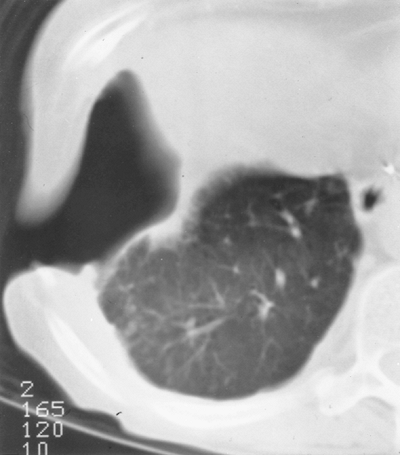 |
Fig. 95-15. Computed tomographic image of the right chest in a patient 3 years after bilateral sequential single-lung transplantation. Previous open lung biopsy resulted in a prolonged bronchopleural fistula and a sizable residual cavity. A Claggett window was created. Ultimately, the fistula closed. The patient has tolerated the Claggett window for 2.5 years. |
Airway complications are identified in a number of ways. Routine postoperative bronchoscopic surveillance, as used in most programs, generally provides early evidence that an anastomotic complication has occurred. On occasion, computed tomography (CT), performed for some other indication, demonstrates an unexpected airway stenosis or dehiscence. In fact, CT scanning is a useful diagnostic tool in the evaluation of documented or suspected donor airway complications. Late airway stenoses generally manifest with symptoms of dyspnea, wheeze, or decreased FEV1. Bronchoscopic assessment confirms the diagnosis.
Failure of Normal Bronchial Healing
Most airway complications are identified soon after transplantation. A normal bronchial anastomotic suture line will demonstrate a narrow rim of epithelial slough that ultimately heals. On occasion, one can observe patchy areas of superficial necrosis of donor bronchial epithelium. These areas are also of no concern and ultimately heal, causing problems. Minor degrees of bronchial dehiscence are also of little long-term consequence. Membranous wall defects generally heal without any airway compromise, whereas cartilaginous defects usually result in some degree of late stricture. Significant dehiscence (greater than 50% of the bronchial circumference) may result in compromise of the airway. This problem should be managed expectantly by laser or mechanical d bridement of the area to maintain satisfactory airway patency. A word of caution should be issued to the laser enthusiasts: Zealous attempts to maintain airway caliber can injure the vital normal distal donor airway. A stent can only be placed if the distal main airway remains intact. Occasionally, a significant dehiscence results in direct communication with the pleural space, resulting in pneumothorax and a significant air leak following chest tube insertion. If the lung remains completely expanded and the pleural space is evacuated, however, the leak will ultimately seal, and the airway may heal without significant stenosis. Similarly, a dehiscence may communicate directly with the mediastinum, resulting in significant mediastinal emphysema. If the lung remains completely expanded and the pleural space is filled, adequate drainage of the mediastinum can be achieved by placing a drain in close proximity to the anastomotic line by mediastinoscopy. This step will also result in satisfactory healing of the anastomosis, often without stricture.
Surgical revision of the anastomosis is only possible if an adequate length of donor airway is available for resuturing. This type of reconstruction has been performed successfully by Kirk and associates (1990). This procedure is rarely possible, however, if the donor bronchus was cut to an appropriate short length at the time of the initial procedure. Massive dehiscence of the airway with uncontrolled leak or mediastinal contamination has been treated by successful retransplantation in a number of programs.
Anastomotic Stenosis
Chronic airway stenoses can present significant management problems. A right main bronchial anastomotic stricture is generally managed easily by repeated dilation and ultimate placement of an endobronchial stent; there is usually sufficient length for placement of a right main bronchial orifice stent without impingement of the right upper lobe bronchus. On the left side, however, strictures can be somewhat more difficult to manage. Dilation of the distal left main bronchus is technically more difficult because of the angulation of that bronchus. In addition, the lobar bifurcation immediately distal to the usual site of anastomosis does not provide a suitable length of bronchus distal to the stricture for placement of large-caliber dilating bronchoscopes. Finally, Silastic stents placed across a distal left main bronchial anastomotic stricture may occlude the upper or lower lobe orifice as they bridge the stricture.
Silastic stents are tolerated exceptionally well. Patients do, however, require daily inhalation of N-acetylcystine to keep the stents patent. De Hoyos and associates (1992) reported that the stents have resulted in dramatic improvement in pulmonary function. Fortunately, most of these stents have proved to be required only temporarily. After several months, most patients are able to maintain satisfactory airway patency without the stent in place.
Self-expanding metal stents have benefited from impressive technologic improvement in recent years. These stents come in a wide variety of lengths and diameters, and they have been exceptionally easy to insert. In rare situations in which the airways distal to an anastomotic stricture are too small to accept a Silastic stent, or when a Silastic stent will obstruct one bronchus while stenting another, the use of a self-expanding metal stent may suit the purpose perfectly. The only caveat is that granulation tissue will rapidly overgrow an uncovered metal mesh stent, sometimes making it impossible to remove.
Finally, distal bronchial strictures can prove unmanageable by dilation or stent insertion. In these patients, retransplantation is an option that has been used successfully by Novick and co-workers (1998).
Rejection
Insofar as immunologic matching is crude (ABO blood group only) and immunosuppression strategies are imperfect, it is not surprising that posttransplantation rejection is a troublesome problem. Acute rejection, as noted by us, is encountered during the early postoperative period in almost all patients. This occurrence rarely presents a significant clinical problem. Chronic rejection, in contrast, is the most common underlying cause of late death following pulmonary
P.1395
transplantation. This problem is particularly vexing because its pathogenesis is poorly understood and no effective means of treatment are known.
Acute Rejection
Acute rejection has a typical clinical presentation including dyspnea, low-grade fever, perihilar interstitial infiltrates (see Fig. 95-14), hypoxia, and increased white blood cell count. Typically, the first episode occurs within the first 5 to 7 postoperative days. Several episodes during the first 2 months are not unusual. In the past, the suspected diagnosis was confirmed by a rapid response to bolus methylprednisolone, typically 500 mg to 1 g. However, the aforementioned clinical scenario can be confused with infection.
At present, the clinical parameters previously described raise the suspicion but are insufficient for the accurate diagnosis of rejection. Intensive laboratory investigations are underway to discover some relatively noninvasive technique by which rejection might be identified. Nuclear scanning has proved to be of little value. Evidence is mounting that various cytokines are important mediators in the development of rejection and that manipulation of their expression may be of therapeutic importance. The role of NO in the pathophysiology of lung allograft rejection is currently being elucidated, but groups such as Fisher and colleagues (1998) have concluded from preliminary studies that the measurement of exhaled NO may have a role as a noninvasive indicator of pulmonary allograft rejection.
The standard and most useful method for the diagnosis of rejection is transbronchial biopsy performed under fluoroscopic control. The Papworth group, whose work was reported by Higenbottam and co-workers (1988), deserves credit for demonstrating the safety and value of this technique in the lung transplantation population. The typical histologic appearance is that of perivascular lymphocytic infiltrate (Fig. 95-16). The internationally accepted classification for pulmonary rejection was revised by Yousem and colleagues (1996) and is depicted in Table 95-4.
Factors that predispose patients to an increased incidence of rejection are unclear. Experimental evidence shows that poorly preserved allografts are more likely to suffer subsequent rejection. In addition, expression of class II major histocompatibility complex (MHC) antigens on bronchial epithelium and pulmonary capillary endothelium is increased after extended periods of preservation. Infection may also predispose to subsequent rejection. Serious rejection episodes following close on the heels of established bacterial or viral infection have been reported.
Irrespective of its etiology, acute rejection usually can be controlled effectively. Most patients respond promptly to the first course of methylprednisolone. Occasionally, a second course of steroid may be necessary to control a serious rejection episode. Persistent rejection despite this intervention is distinctly unusual. In this latter circumstance, cytolytic therapy with ATG or OKT3 should be considered. Evidence suggests that alternative immunosuppressants such as FK-506 also may be useful in this situation. Increasing experimental evidence, as noted by Hirai and associates (1993), shows that FK-506 may offer an advantage over cyclosporine as a first-line immunosuppressive agent. New investigations on the value of tacrolimus over cyclosporine for acute rejection are necessary.
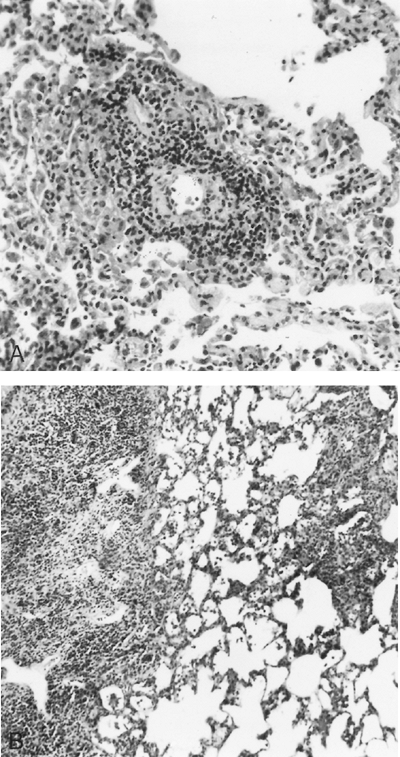 |
Fig. 95-16. A. Photomicrograph of a transbronchial biopsy specimen showing typical early (A1b) rejection. Isolated perivascular cuffs of lymphocytes are noted. B. A more severe degree of rejection is evident in this photomicrograph of a transbronchial biopsy specimen. Perivascular and interstitial lymphoid infiltrates are present, consistent with grade 3 rejection (A3a). |
Table 95-4. Working Formulation for Classification and Grading of Pulmonary Rejection | |
|---|---|
|
P.1396
Chronic Rejection Bronchiolitis Obliterans Syndrome
Unfortunately, chronic rejection remains a major problem. The clinical presentation of chronic rejection is a progressive fall in FEV1, which may actually precede clinical symptoms of dyspnea and can be detected by the hand-held spirometer used daily by patients in almost all transplant programs. Despite advanced chronic rejection, chest radiographs and CT scans may be normal. They should be performed, however, to rule out other causes of a decreasing FEV1. Bronchoscopy is necessary to ensure that there is no bronchial anastomotic compromise. Pulmonary function studies reveal obstructive physiologic change. The pathologic hallmark of chronic rejection is obliterative bronchiolitis (Fig. 95-17). Indeed, the term chronic rejection is often used interchangeably with bronchiolitis obliterans. The descriptive term bronchiolitis obliterans syndrome (BOS) has been used to describe the commonly encountered late decline in graft function, which is not attributable to acute rejection, infection, or mechanical obstruction due to a bronchial anastomotic complication. A working formulation has been created by Cooper and colleagues (1993) to characterize and grade BOS (Table 95-5). The histologic diagnosis of obliterative bronchiolitis is a modifier of the classification of stage of disease, but it is not necessary to make the diagnosis.
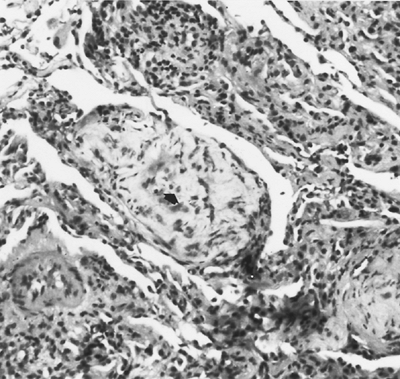 |
Fig. 95-17. Photomicrograph of a transbronchial biopsy specimen reveals typical findings of bronchiolitis obliterans thought to result from chronic rejection. Mature fibrous obliteration of the bronchiolar lumen is evident (arrow). |
The prevalence of BOS among lung transplant recipients increases steadily with increasing time since the transplantation. Reichenspurner and the Stanford group (1995) reported an extensive experience with BOS in heart-lung and lung transplant recipients. They reported actuarial freedom from BOS in 72%, 52%, 44%, and 29% of recipients at 1, 2, 3, and 5 years posttransplantation, respectively. There was no significant difference between lung transplant recipients and heart-lung transplant recipients in the prevalence of
P.1397
BOS. Multivariate analysis listed CMV infection, acute rejection, and biopsy findings of lymphocytic bronchiolitis as being associated with increased risk for BOS. Similarly, Chaparro and colleagues (1997) from the University of Toronto report a stage I or higher BOS prevalence of 63% for transplant recipients surviving more than 5 years.
Table 95-5. Bronchiolitis Obliterans Syndrome Scoring System | ||||||||
|---|---|---|---|---|---|---|---|---|
|
Our experience with BOS was reported by Sundaresan and associates (1995b) in a retrospective review of 212 transplant recipients. As a group, 41% had been classified as having BOS, whereas 59% were free of BOS. When grouped as successive quartiles based on time since transplantation, 56% of the longest surviving quartile had BOS, whereas 9.6% of the most recently transplanted quartile had BOS. Mortality was 28.6% for patients with BOS, as compared with 7.3% for those without it. Death generally occurred due to primary graft dysfunction, or as a result of infection in the setting of augmented immunosuppression used to treat BOS.
Prevention of BOS depends on preventing those clinical situations that have been shown to be associated with its development. The avoidance of acute rejection episodes and the avoidance of CMV infections through careful clinical monitoring and routine surveillance biopsies are potential approaches. Ciccone and associates (2002) reported that donor cause of death was associated with the risk for subsequent development of BOS in the recipient. Once BOS is established, intensification of immunosuppression with azathioprine, steroids, Atgam, methotrexate, irradiation, and aerosolized cyclosporine has been explored as treatment. None has reversed the dysfunction. The goal of present treatment is to arrest the progressive decline. Unfortunately, most patients either develop progressive obliterative bronchiolitis or contract an opportunistic infection that proves lethal.
Retransplantation has been offered to many patients with chronic rejection, as noted by Novick and colleagues (1998). Retransplantation has been explored as therapy for end-stage BOS, but results demonstrate significantly worse survival than is seen after primary lung transplantation. Recent data on the ISHLT Web site (2003) suggests that 1-year survival rates after retransplantation are 58%, as compared with 76% for the large majority who are first-time recipients. Retransplantation remains controversial in the face of ever-increasing waiting lists for first-time transplant recipients. For many of these patients, the process reappears in a short period of time after retransplantation. Nonetheless, a few patients have survived and obtained excellent long-term results after retransplantation for this devastating condition.
Table 95-6. Patient Actuarial Survival, Washington University Lung Transplant Program: Survival Stratified by Diagnoses (1988 2002) | ||||||||||||||||||||||||||||||||||||||||||||||||||||||
|---|---|---|---|---|---|---|---|---|---|---|---|---|---|---|---|---|---|---|---|---|---|---|---|---|---|---|---|---|---|---|---|---|---|---|---|---|---|---|---|---|---|---|---|---|---|---|---|---|---|---|---|---|---|---|
|
RESULTS
Operative Mortality
Improvements in selection, technique, and management have resulted in dramatic reductions in operative mortality. Cooper and co-workers (1994) reported an early mortality of only 8% in 131 consecutive single and bilateral transplantations performed in our program. Updated survival data are illustrated in Table 95 6, with 30-day survival in excess of 90% for all diagnoses. Other large programs have reported equally impressive results. Huddleston and colleagues (2002) at Washington University reported exciting results of lung transplantation in children.
Some difference in early mortality apparently depends on the type of procedure or underlying disease. In the early years of bilateral lung transplantation, bilateral procedures were associated with early operative mortality rates, which were higher than those seen after single-lung transplantation. In recent years, the mortality of bilateral procedures has decreased, and in our program, there is no difference between single-lung transplant and bilateral-lung transplant survival at 1 month (96% vs. 95%) or at 1 year (85% vs. 83%). In our program, we noted no difference in perioperative mortality among disease categories for which single-lung transplantation is undertaken. The causes of operative mortality as reported by the ISHLT are shown in Table 95-7.
Late Mortality
Survival data from the ISHLT Registry are shown in Figure 95-18. Considering the fact that many of the programs reporting to the registry have limited experience, the overall worldwide results are impressive and are improving steadily. The primary causes of late deaths as reported to ISHLT are shown in Table 95-7.
Table 95-7. Cause of Mortality after Lung Transplantation, Grouped by Interval since Transplantation | ||||||||||||||||||||||||||||||||||||||||||||||||
|---|---|---|---|---|---|---|---|---|---|---|---|---|---|---|---|---|---|---|---|---|---|---|---|---|---|---|---|---|---|---|---|---|---|---|---|---|---|---|---|---|---|---|---|---|---|---|---|---|
| ||||||||||||||||||||||||||||||||||||||||||||||||
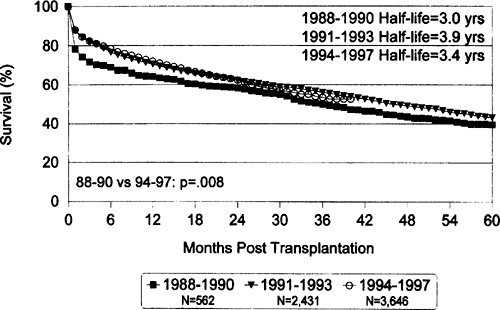 |
Fig. 95-18. Overall actuarial survival among lung transplant recipients registered in the International Society of Heart and Lung Transplantation. From Hosenpud JD, et al: The Registry of the International Society for Heart and Lung Transplantation: Fifteenth Official Report 1998. J Heart Lung Transplant 17:656, 1998. With permission. |
 |
Fig. 95-19. Preoperative and postoperative room air Pao2 among adult recipients in the Washington University Barnes Hospital experience according to disease categories. Note the dramatic and sustained increase in oxygenation in all patient groups. |
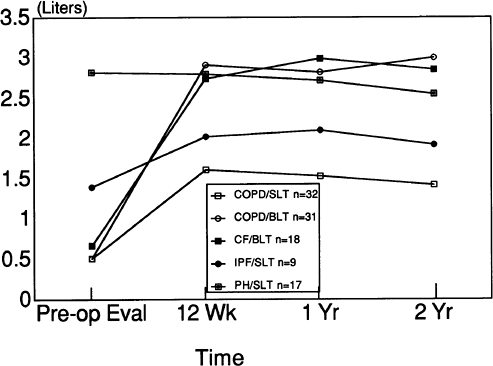 |
Fig. 95-20. Preoperative and postoperative FEV1 among adult recipients in the Washington University Barnes Hospital experience according to disease categories. Dramatic and sustained improvements are noted in bilateral (BLT) recipients having chronic obstructive pulmonary disease (COPD) or cystic fibrosis (CF). Less dramatic improvements in FEV1 are noted in single-lung transplant (SLT) recipients suffering from COPD or idiopathic pulmonary fibrosis (IPF). SLT recipients with pulmonary hypertension (PH) having normal preoperative FEV1 derive no improvement in that parameter after transplantation. |
 |
Fig. 95-21. Preoperative and postoperative 6-minute walk distances (meters) for adult recipients in the Washington University Barnes Hospital program according to various disease and transplant categories. Note the dramatic improvement in exercise tolerance in all patient groups. This improvement appears to be sustained, except perhaps in the chronic obstructive pulmonary disease (COPD) group receiving single-lung transplantation (SLT), in whom there is a slight decrease noted in late follow-up. BLT, bilateral-lung transplantation; CF, cystic fibrosis; IPF, idiopathic pulmonary fibrosis; PH, pulmonary hypertension. |
P.1398
P.1399
Functional Results
Among operative survivors, functional results are excellent. The usual patient is returned to normal levels of exercise tolerance without oxygen supplementation within 6 to 8 weeks after transplantation.
Obstructive Lung Disease
Obstructive lung disease is the most common indication for lung transplantation. Single and bilateral lung transplantations have been used with success. Gas exchange, pulmonary function, and exercise tolerance are dramatically improved, as illustrated in Figures 95-19, 95-20 and 95-21. Single and bilateral recipients achieve satisfactory postoperative lung volume (Figs. 95-22 and 95-23).
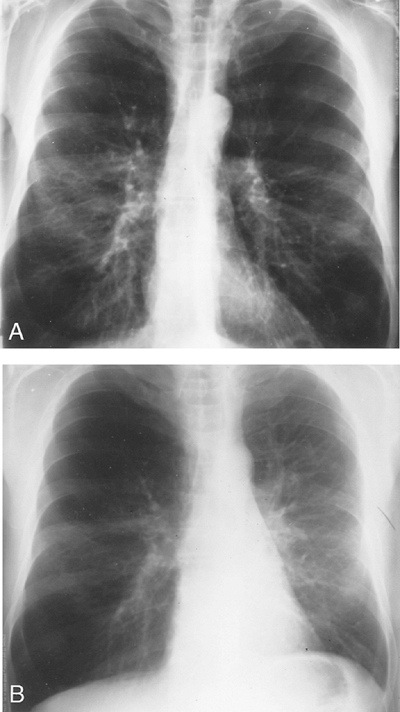 |
Fig. 95-22. A. Preoperative chest radiograph in a patient with emphysema. B. Same patient after left single-lung transplantation. Despite receiving an allograft with greater predicted lung volume than the recipient, the mediastinum is still shifted slightly to the transplanted side. |
Septic Lung Disease
In a number of centers, satisfactory results have been obtained with the application of bilateral-lung transplantation in these patients. The authors experience is similar (see Figs. 95-19, 95-20 and 95-21). Dramatic improvement in chest contour is apparent (Fig. 95-24).
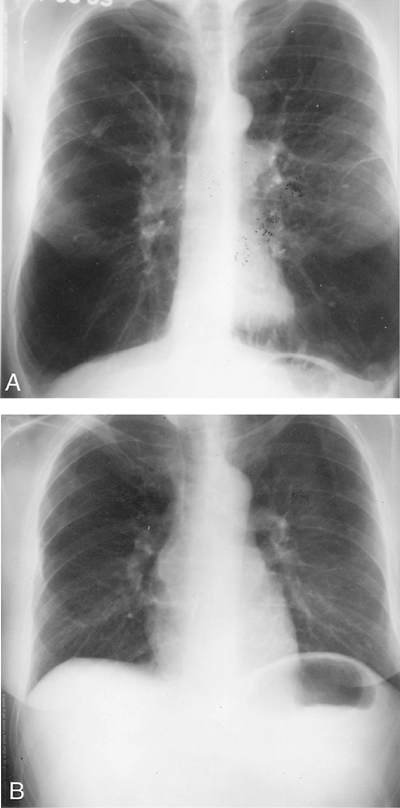 |
Fig. 95-23. A. Preoperative chest radiograph in a patient with 1-antitrypsin deficiency emphysema. B. After bilateral sequential single-lung transplantation. Note the return to normal chest contour with restoration of a normal cardiac silhouette. |
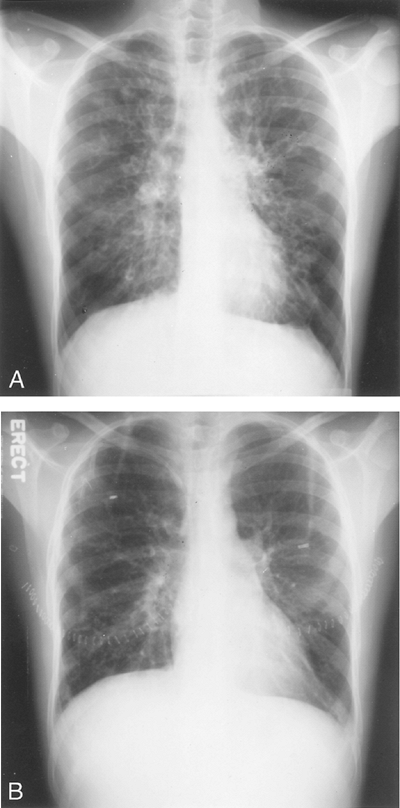 |
Fig. 95-24. A. Preoperative chest radiograph from a patient with cystic fibrosis. B. After bilateral sequential single-lung transplantation. Note the return of normal chest contour. |
P.1400
Fibrotic Lung Disease
Whereas fibrotic lung disease condition was formerly the most frequent indication for pulmonary transplantation, it is now one of the least common indications. Nonetheless, enough data are available to realize that the long-term functional results in this group of patients are excellent. As reported by one of the authors (BFM) and co-workers (2000c), we have achieved a 54% survival at 5 years for the fibrotic patients. Single-lung transplantation provides satisfactory lung volume for these patients (Fig. 95-25). Gas exchange and exercise tolerance are maintained during late follow-up (see Figs. 95-19, 95-20, 95-21).
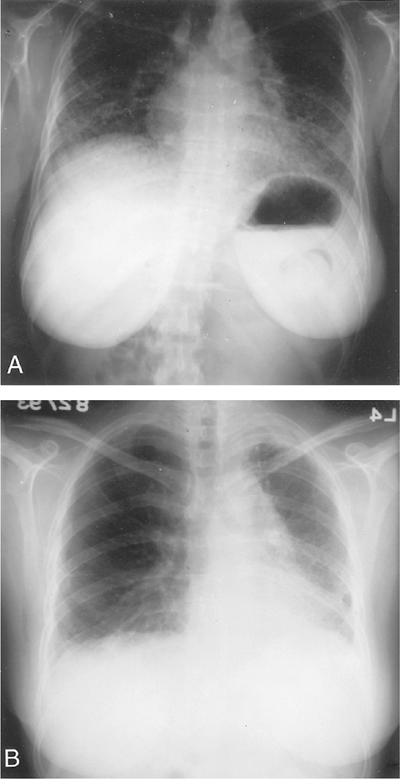 |
Fig. 95-25. A. Preoperative chest radiograph in a patient with idiopathic pulmonary fibrosis. Note the diffuse interstitial markings and small lung volumes. B. After right single-lung transplantation. With placement of an oversized right lung allograft, the mediastinum has been shifted to the left. |
Pulmonary Vascular Disease
It is well documented that the cardiac function of patients with pulmonary hypertension recovers promptly with the reduction in right ventricular afterload provided by satisfactory lung transplantation. However, the early postoperative
P.1401
course of these patients is complicated because of the impressive ventilation-perfusion mismatch that may occur as 90% to 95% of right ventricular output is directed to the transplanted lung and more than 50% of ventilation is directed to the native lung. Of 100 adult and pediatric patients undergoing transplantation for pulmonary vascular disease, Mendeloff and colleagues (2002) reported a 1-year survival of 75% and a 5-year survival of 57%. Mean New York Heart Association functional class improved from a pretransplantation value of 3.2 to a posttransplantation value of 1.3. Gas exchange and exercise tolerance data reported by Pasque and co-workers (1995), depicted in Figures 95-19 to 95-21, demonstrate that these patients have functional results equivalent to any other transplant group. Postoperative radiographs of the chest illustrate the preponderance of pulmonary artery flow to the transplanted lung (Fig. 95-26).
Follow-up hemodynamic data for the first 34 patients receiving single-lung transplants in our program are depicted in Table 95-8, as reported by Pasque and colleagues (1995). After transplantation, the measured mean pulmonary artery pressure dropped from 65 to 23 mm Hg; the cardiac index (liters per minute per square meter) improved from 2.2 to 3.4; and the calculated pulmonary vascular resistance decreased from 1,361 to 190. The hemodynamic benefits conferred by single-lung transplantation to recipients with pulmonary hypertension have been shown to be durable for up to 4 years.
The standard operation previously offered these patients, combined heart-lung transplantation, is still practiced widely, particularly in the United Kingdom. These bilateral-lung replacement procedures may have a long-term advantage over single-lung transplantation in this patient group. Patients undergoing single-lung transplantation for pulmonary hypertension do exceedingly well as long as bronchiolitis obliterans can be avoided. When BOS develops in PPH or patients with Eisenmenger's syndrome receiving single-lung transplants, the resultant functional impairment is severe. Despite the theoretic early and late advantages of bilateral transplantation, neither Gammie and colleagues (1998) nor Mendleloff and associates (2002) could demonstrate a measurable survival advantage or functional benefit for bilateral transplants over single-lung transplants.
FUTURE DIRECTIONS
Recent evidence reported by Davis and colleagues (2003) suggests an association between gastroesophageal reflux and bronchiolitis obliterans syndrome. Abnormal reflux was found in 73% of tested lung recipients, and fundoplication was performed in half of the patients with documented reflux. Pulmonary function testing demonstrated improved lung function in the patients treated with fundoplication. This work points to another avenue of research to identify and treat causes of chronic posttransplantation lung dysfunction.
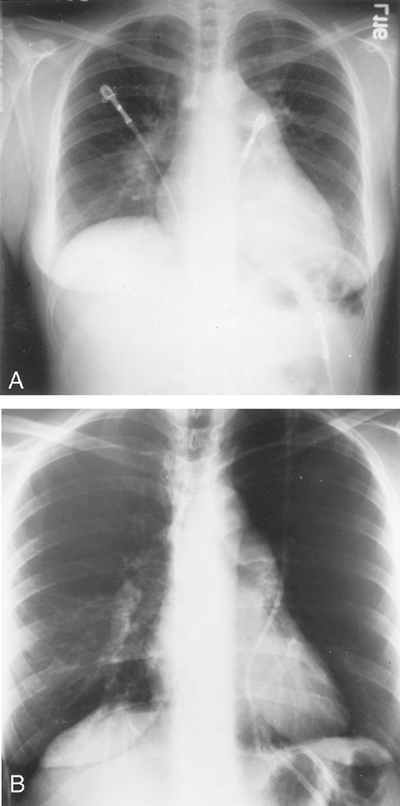 |
Fig. 95-26. A. Preoperative chest radiograph in a patient with primary pulmonary hypertension. Note the tremendous enlargement of the right ventricle and pulmonary arteries. B. One month after right single-lung transplantation. Note the dramatic reduction in right ventricular and pulmonary arterial size. The relative lack of perfusion to the native lung is apparent from the absence of vascular markings on the left side. |
Other work has been reported by Jaramillo (2003) and Palmer (2002) and colleagues that sheds additional light on the immunologic aspects of chronic rejection and bronchiolitis obliterans syndrome. Specifically, both groups have shown associations between the development of anti-HLA antibodies in the sera of lung transplant recipients and the subsequent development of bronchiolitis obliterans syndrome. As additional work clarifies the mechanism of this
P.1402
phenomenon, we draw closer to the time when specific therapeutic interventions will be available to treat this form of chronic rejection.
Table 95-8. Mean Hemodynamics before and after Lung Transplantation for Pulmonary Hypertension | ||||||||||||||||||||||||||||||||||||||||||||||||||||||
|---|---|---|---|---|---|---|---|---|---|---|---|---|---|---|---|---|---|---|---|---|---|---|---|---|---|---|---|---|---|---|---|---|---|---|---|---|---|---|---|---|---|---|---|---|---|---|---|---|---|---|---|---|---|---|
| ||||||||||||||||||||||||||||||||||||||||||||||||||||||
Another potential avenue of investigation is the ex vivo modification of the lung allograft to improve its function or render it resistant to common posttransplantation complications. Kanaan and colleagues (2002), working with our group, have demonstrated successful gene transfer into lung isografts using adenovirus-mediated or liposome-mediated gene transfer. This early work shows promise for the eventual ability to insert therapeutic genes into the endothelial cells of a lung graft before surgical implantation into a recipient.
ADDENDUM
The senior editor was informed by A. Brutel de la Rivi re (personal communication, 2002) of the satisfactory use of a median sternotomy approach for transplantation of the left lung. The use of this incision was facilitated by the employment of the Octupus system 11 with the Starfish 2 heart positioner (Medtronic, Inc., Minneapolis, MN) to retract the heart out of the pericardial sac without resulting left or right ventricular dysfunction. E. S. L. Jansen of Brutel's group noted that this approach allows safe intrapericardial dissection of the vessels and facilitates exposure of the posterior portion of the visceral compartment for access the tracheobronchial tree. Exposure of the hilum (mainly the left) is excellent, and transplantation can be accomplished without the use of cardiopulmonary bypass. Macchiarini and associates (1999) also have described the use of a median sternotomy in lung transplantation, but cardiopulmonary bypass was required in all.
REFERENCES
Adnot S, Raffestin B: Pulmonary hypertension: NO therapy? Thorax 51: 762, 1996.
Aoe M, et al: Administration of prostaglandin E1 after lung transplantation improves early graft function. Ann Thorac Surg 58:655, 1994.
Ardehali A, et al: A prospective trial of inhaled nitric oxide in clinical lung transplantation. Transplantation 72:112, 2001.
Barst RJ, et al: A comparison of continuous intravenous epoprostenol (prostacyclin) with conventional therapy for primary pulmonary hypertension. The Primary Pulmonary Hypertension Study Group. N Engl J Med 334:296, 1996.
Battafarano RJ, et al: Perioperative complications after living donor lobectomy. J Thorac Cardiovasc Surg 120:909, 2000.
Bhabra MS, et al: Critical importance of the first 10 minutes of lung graft reperfusion after hypothermic storage. Ann Thorac Surg 61:1631, 1996.
Brock MV, et al: Induction therapy in lung transplantation: a prospective, controlled clinical trial comparing OKT3, anti-thymocyte globulin, and daclizumab. J Heart Lung Transplant 20:1282, 2001.
Chaparro C, Kesten S: Infections in lung transplant recipients. Clin Chest Med 18:339, 1997.
Chaparro C, et al: Status of lung transplant recipients surviving beyond five years. J Heart Lung Transplant 16:511, 1997.
Christie NA, Waddell TK: Lung preservation. Chest Surgery Clin N Am 3:29, 1993.
Ciccone AM, et al: Does donor cause of death affect the outcome of lung transplantation? J Thorac Cardiovasc Surg 123:429, 2002.
Cooper JD, et al: A working formulation for the standardization of nomenclature and for clinical staging of chronic dysfunction in lung allografts. International Society for Heart and Lung Transplantation. J Heart Lung Transplant 12:713, 1993.
Cooper JD, Patterson GA, Trulock EP: Results of single and bilateral lung transplantation in 131 consecutive recipients. Washington Univesity Lung Transplant Group. J Thorac Cardiovasc Surg 107:460, 1994.
D'Alonzo GE, et al: Survival in patients with primary pulmonary hypertension. Results from a national prospective registry. Ann Intern Med 115:343, 1991.
Dark JH: Experimental en-bloc double-lung transplantation. Ann Thorac Surg 42:394, 1986.
Date H, et al: Improved airway healing after lung transplantation. An analysis of 348 bronchial anastomoses. J Thorac Cardiovasc Surg 110: 1424, 1995.
Date H, et al: Inhaled nitric oxide reduces human lung allograft dysfunction. J Thorac Cardiovasc Surg 111:913, 1996.
Davis RD Jr, et al: Improved lung allograft function after fundoplication in patients with gastroesophageal reflux disease undergoing lung transplantation. J Thorac Cardiovasc Surg 125:533, 2003.
Davreux C, et al: Improved tracheal allograft viability in immunosuppressed rats. Ann Thorac Surg 55:131, 1993.
de Hoyos A, et al: Pulmonary transplantation: early and late results. The Toronto Lung Transplant Group. J Thorac Cardiovasc Surg 103:295, 1992.
Derom F, et al: Ten-month survival after lung homotransplantation in man. J Thorac Cardiovasc Surg 61:835, 1971.
Eriksson LT, Steen S: Induced hypothermia in critical respiratory failure after lung transplantation. Ann Thorac Surg 65:827, 1998.
Etienne B, et al: Successful double-lung transplantation for bronchioalveolar carcinoma. Chest 112:1423, 1997.
Ettinger NA, et al: Cytomegalovirus infection and pneumonitis. Impact after isolated lung transplanation. Washington University Lung Transplant Group. Am Rev Respir Dis 147:1017, 1993.
Fiser SM, et al: Early intervention after severe oxygenation index elevation improves survival following lung transplantation. J Heart Lung Transplant 20:631, 2001.
P.1403
Fisher AJ, et al: Cross sectional study of exhaled nitric oxide levels following lung transplantation. Thorax 53:454, 1998.
Fremes SE, et al: Single lung transplantation and closure of patent ductus arteriosus for Eisenmenger's syndrome. Toronto Lung Transplant Group. J Thorac Cardiovasc Surg 100:1, 1990.
Fujino S, et al: Inhaled nitric oxide at the time of harvest improves early lung allograft function. Ann Thorac Surg 63:1383, 1997.
Gaissert HA, et al: Comparison of early functional results after volume reduction or lung transplantation for chronic obstructive pulmonary disease. J Thorac Cardiovasc Surg 111:296, 1996.
Gammie JS, et al: Single- versus double-lung transplantation for pulmonary hypertension. J Thorac Cardiovasc Surg 115:397, 1998.
Goldberg M, et al: A comparison between cyclosporin A and methylprednisolone plus azathioprine on bronchial healing following canine lung transplantation. J Thorac Cardiovasc Surg 85:821, 1983.
Griffith BP, et al: Anastomotic pitfalls in lung transplantation. J Thorac Cardiovasc Surg 107:743, 1994.
Haddy SM, et al: Hyperinflation resulting in hemodynamic collapse following living donor lobar transplantation. Anesthesiology 97:1315, 2002.
Halldorsson A, et al: Controlled reperfusion after lung ischemia: implications for improved function after lung transplantation. J Thorac Cardiovasc Surg 115:415, 1998a.
Halldorsson A, et al: Controlled reperfusion prevents pulmonary injury after 24-hours of lung preservation. Ann Thorac Surg 66:877, 1998b.
Harari S, et al: Prognostic value of pulmonary hypertension in patients with chronic interstitial lung disease referred for lung or heart-lung transplantation. J Heart Lung Transplant 16:460, 1997.
Hardin CA, Kittle CF: Experiences with transplantation of the lung. Science 119:97, 1954.
Hardy JD, et al: Lung homotransplantation in man. JAMA 186:1065, 1963.
Haydock DA, et al: Management of dysfunction in the transplanted lung: experience with 7 clinical cases. Washington University Lung Transplant Group. Ann Thorac Surg 53:635, 1992.
Hayllar KM, et al: A prognostic model for the prediction of survival in cystic fibrosis. Thorax 52:313, 1997.
Higenbottam T, et al: Transbronchial lung biopsy for the diagnosis of rejection in heart-lung transplant patients. Transplantation 46:532, 1988.
Hirai T, et al: Prolonged lung allograft survival with short course of FK 506. J Thorac Cardiovasc Surg 105:1, 1993.
Hopkinson DN, Bhabra MS, Hooper TL: Pulmonary graft preservation: a worldwide survey of current clinical practice. J Heart Lung Transplant 17:525, 1998.
Horning NR, et al: Tacrolimus therapy for persistent or recurrent acute rejection after lung transplantation. J Heart Lung Transplant 17:761, 1998.
Hosenpud JD, et al: The Registry of the International Society for Heart and Lung Transplantation: fifteenth official report 1998. J Heart Lung Transplant 17:656, 1998.
Huddleston CB, et al: Lung retransplantation in children. Ann Thorac Surg 66:199, 1998.
Huddleston CB, et al: Lung transplantation in children. Ann Surg 236:270, 2002.
Inui K, et al: Bronchial circulation after experimental lung transplantation. The effect of long term administration of prednisolone. J Thorac Cardiovasc Surg 105:474, 1993.
ISHLT. ISHLT Website, http://www.ishlt.org, International Society for Heart and Lung Transplantation, 2003.
Jaramillo A, et al: Anti-HLA class I antibody binding to airway epithelial cells induces production of fibrogenic growth factors and apoptotic cell death: a possible mechanism for bronchiolitis obliterans syndrome. Hum Immunol 64:521, 2003.
Kanaan SA, et al: Intratracheal adenovirus-mediated gene transfer is optimal in experimental lung transplantation. J Thorac Cardiovasc Surg 124:1130, 2002.
Kerem E, et al: Prediction of mortality in patients with cystic fibrosis. N Engl J Med 326:1187, 1992.
Kirk AJ, et al: Successful surgical management of bronchial dehiscence after single-lung transplantation. Ann Thorac Surg 49:147, 1990.
Kozower B, et al: Potential for detrimental hyperinflation after lung transplantation with application of negative pleural pressure to undersized lung grafts. J Thorac Cardiovasc Surg 125:430, 2003.
Kroshus TJ, Bolman RM 3rd, Kshettry VR: Unilateral volume reduction after single-lung transplantation for emphysema. Ann Thorac Surg 62: 363, 1996.
Lima O, et al: Effects of methylprednisolone and azathioprine on bronchial healing following lung autotransplantation. J Thorac Cardiovasc Surg 82:211, 1981.
Macchiarini P, et al: Clamshell or sternotomy for double lung or heart-lung transplantation. Eur J Thorac Surg 15:333, 1999.
Maurer JR, et al: International guidelines for the selection of lung transplant candidates. The International Society for Heart and Lung Transplantation, the American Thoracic Society, the American Society of Transplant Physicians, the European Respiratory Society. J Heart Lung Transplant 17:703, 1998.
Mayer E, et al: Reliable eighteen-hour lung preservation at 4 degrees and 10 degrees C by pulmonary artery flush after high-dose prostaglandin E1. J Thorac Cardiovasc Surg 103:1136, 1992.
Meade MO, et al: A randomized trial of inhaled nitric oxide to prevent ischemia-reperfusion injury after lung transplantation. Am J Respir Crit Care Med 167:1483, 2003.
Mendeloff EN, et al: Pediatric and adult lung transplantation for cystic fibrosis. J Thorac Cardiovasc Surg 115:404, 1997.
Mendeloff EN, et al: Lung transplantation for pulmonary vascular disease. Ann Thorac Surg 73:209, 2002.
Metras H: Note preliminare sur la greffe totale du poumon chez le chien. C R Acad Sci (Paris) 231:1176, 1950.
Meyers BF, et al: Bilateral sequential lung transplantation without sternal division eliminates posttransplantation sternal complications. J Thorac Cardiovasc Surg 117:358, 1999.
Meyers BF, et al: Lung transplantation is warranted for stable ventilator-dependent recipients. Ann Thorac Surg 70:1675, 2000a.
Meyers BF, et al: Selective use of extracorporeal membrane oxygenation is warranted after lung transplantation. J Thorac Cardiovasc Surg 120: 20, 2000b.
Meyers BF, et al: Single versus bilateral lung transplantation for idiopathic pulmonary fibrosis: a ten year institutional experience. J Thorac Cardiovasc Surg 120:99, 2000c.
Meyers BF, et al: Outcome of lung volume reduction surgery in emphysema patients eligible for lung transplantation. J Thorac Cardiovasc Surg 122:10, 2001.
Milla CE, Warwick WJ: Risk of death in cystic fibrosis patients with severely compromised lung function. Chest 113:1230, 1998.
Morgan E, et al: Successful revascularization of totally ischemic bronchial autografts with omental pedicle flaps in dogs. J Thorac Cardiovasc Surg 84:204, 1982.
Novick RJ, et al: Lung preservation: the importance of endothelial and alveolar type II cell integrity. Ann Thorac Surg 62:302, 1996.
Novick RJ, et al: Pulmonary retransplantation: predictors of graft function and survival in 230 patients. Pulmonary Retransplant Registry. Ann Thorac Surg 65:227, 1998.
Okamoto F, et al: Reperfusion conditions: importance of ensuring gentle versus sudden reperfusion during relief of coronary occlusion. J Thorac Cardiovasc Surg 92:613, 1986.
Palmer SM, et al: Development of an antibody specific to major histocompatibility antigens detectable by flow cytometry after lung transplant is associated with bronchiolitis obliterans syndrome. Transplantation 74: 799, 2002.
Pasque MK, et al: An improved technique for bilateral lung transplantation: rationale and initial clinical experience. Ann Thorac Surg 49:785, 1990.
Pasque MK, et al: Single lung transplantation for pulmonary hypertension: single institution experience in 34 patients. Circulation 92:2252, 1995.
Patterson G: Airway complications. Chest Surg Clin N Am 3:157. 1993.
Patterson GA, et al: Technique of successful clinical double-lung transplantation. Ann Thorac Surg 45:626, 1988.
Patterson GA, et al: Airway complications after double lung transplantation. Toronto Lung Transplant Group. J Thorac Cardiovasc Surg 99:14, 1990.
Pierre AF, et al: Marginal donor lungs: a reassessment. J Thorac Cardiovasc Surg 123:421, 2002.
Pochettino A, Bavaria JE: Anterior axillary muscle-sparing thoracotomy for lung transplantation. Ann Thorac Surg 64:1846, 1997.
Puskas J, et al: Reliable 30-hour lung preservation by donor hyperinflation. J Thorac Cardiovasc Surg 104:1075, 1992.
Reichenspurner H, et al: Obliterative bronchiolitis after lung and heart-lung transplantation. Ann Thorac Surg 60:1845, 1995.
Reitz B, et al: Heart-lung transplantation: successful therapy for patients with pulmonary vascular disease. N Engl J Med 306:557, 1982.
P.1404
Schaefers HJ, et al: Cardiac innervation after double lung transplant. Toronto Lung Transplant Group. J Thorac Cardiovasc Surg 99:22, 1990.
Schmid RA, et al: Carbohydrate selectin inhibitor CY-1503 reduces neutrophil migration and reperfusion injury in canine pulmonary allografts. J Heart Lung Transplant 16:1054, 1997.
Shiraishi Y, et al: Use of leukocyte depletion to decrease injury after lung preservation and rewarming ischemia an experimental model. J Heart Lung Transplant 17:250, 1998.
Snell GI, et al: Pseudomonas cepacia in lung transplant recipients with cystic fibrosis. Chest 103:466, 1993.
Starnes VA, et al: Experience with living-donor lobar transplantation for indications other than cystic fibrosis. J Thorac Cardiovasc Surg 114: 917, 1997.
Starnes VA, et al: A decade of living lobar transplantation: recipient outcomes. J Thorac Cardiovasc Surg 127:114, 2004.
Straznicka M, et al: Aggressive management of lung donors classified as unacceptable: excellent recipient survival one year after transplantation. J Thorac Cardiovasc Surg 124:250, 2002.
Sundaresan S, et al: Lung preservation with low potassium dextran flush in a primate bilateral transplant model. Ann Thorac Surg 56:1129, 1993a.
Sundaresan S, et al: Donor lung procurement: assessment and operative technique. Ann Thorac Surg 56:1409, 1993b.
Sundaresan S, et al: Successful outcome of lung transplantation is not compromised by the use of marginal donor lungs. J Thorac Cardiovasc Surg 109:1075, 1995a.
Sundaresan S, et al: Prevalence and outcome of bronchiolitis obliterans syndrome after lung transplantation. Washington University Lung Transplant Group. Ann Thorac Surg 60:1341, 1995b.
Szeto WY, et al: Cardiopulmonary bypass for bilateral sequential lung transplantation in patients with chronic obstructive pulmonary disease without adverse effect on lung function or clinical outcome. J Thorac Cardiovasc Surg 124:241, 2002.
Thabut G, et al: Preventive effect of inhaled nitric oxide and pentoxifylline on ischemia/reperfusion injury after lung transplantation. Transplantation 71:1295, 2001.
Todd TR, et al: Separate extraction of cardiac and pulmonary grafts from a single organ donor. Ann Thorac Surg 46:356, 1988.
Todd TR, et al: Simultaneous single-lung transplantation and lung volume reduction. Ann Thorac Surg 63:1468, 1997.
Toronto Lung Transplant Group. Unilateral lung transplantation for pulmonary fibrosis. N Engl J Med 314:1140, 1986.
Trulock EP, et al: The registry of the International Society for Heart and Lung Transplantation: Twentieth Official Adult Lung and Heart-Lung Transplant Report 2003. J Heart Lung Transplant 22:625, 2003.
UNOS: 1998 Annual Report of the U.S. Scientific Registry for Transplant Recipients and the Organ Procurement and Transplantation Network: Transplant Data: 1988 1997. Rockville, MD: U.S. Department of Health and Human Services, Health Resources and Services Administration, Office of Special Programs, Division of Transplantation, 1999.
Unruh HW: Lung preservation and lung injury. Chest Surg Clin North Am 5:91, 1995.
Varela A, et al: Early lung allograft function after retrograde and antegrade preservation. J Thorac Cardiovasc Surg 114:1119, 1997.
Vitulo P, et al: Efficacy of tacrolimus rescue therapy in refractory acute rejection after lung transplantation. J Heart Lung Transplant 21:435, 2002.
Wang L, et al: Influence of temperature of flushing solution on lung preservation. Ann Thorac Surg 55:711, 1993.
Yousem SA, et al: Revision of the 1990 working formulation for the classification of pulmonary allograft rejection: Lung Rejection Study Group. J Heart Lung Transplant 15(1 Pt 1):1, 1996.
Zorn GL Jr, et al: Pulmonary transplantation for advanced bronchioloalveolar carcinoma. J Thorac Cardiovasc Surg 125:45, 2003.
EAN: 2147483647
Pages: 203